SWORD ART ONLINE Fractured Daydream was provided by Bandai Namco Entertainment for review. Thank you!
SWORD ART ONLINE is a franchise that has divided many. I remember when the anime aired its first episodes, which had a great response. But since then, the franchise has had ups and downs, no more so than in its video game adaptations, which often receive a mediocre response from players. But Fractured Daydream may be a big step up for the series.
It should be noted here that Fractured Daydream is primarily an online title. While you can play offline, you'll only have the game's story mode and miss out on the extra multiplayer-only modes. Also, suppose you choose to play in online mode and lose connection, such as by being inactive for some time or by putting your device in sleep mode and waking it up again. In that case, you will be sent back to the main menu, losing that current mission's progress, even in the single-player story mode.
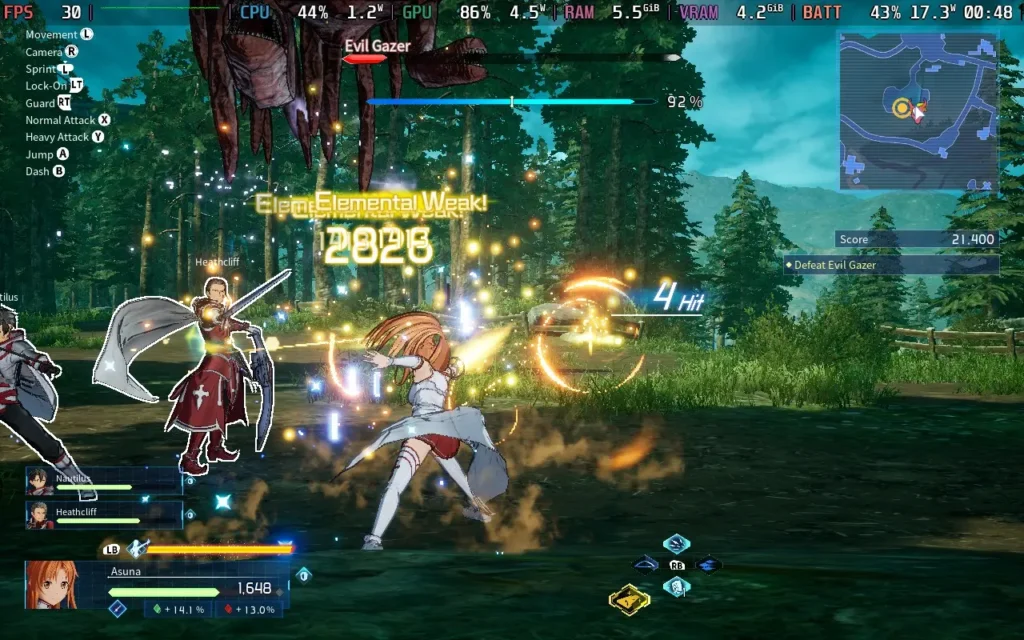
Approaching Fractured Daydream's story from the viewpoint of someone with minimal experience with SWORD ART ONLINE is a little daunting. The game is designed for fans of the series, and because of that, you'll see references to other pieces of media that you likely won't understand if you aren't versed in the lore. Notably, characters are not introduced, and players are expected to know who they are and their relationship with Kirito, the primary protagonist of the franchise and this game's protagonist.
The game's story mode is structured into many short and sweet missions. They tend to be pretty dialogue-heavy and range in length from around 5 minutes to around 15 minutes. Some are more cutscene than gameplay, but the story is interesting and well-voiced. There is only a Japanese dub available, so there is no English voice acting. The average player will probably take 7-8 hours to play through the story mode.
The storyline involves a new feature being added to the virtual world that has caused a glitch, resulting in mass confusion for the players in the game (including amnesia because this is anime). Odd events begin occurring, such as virtual entities appearing that shouldn't be able to exist in this world. It's up to Kirito and his party to find out what happened and how to fix it.
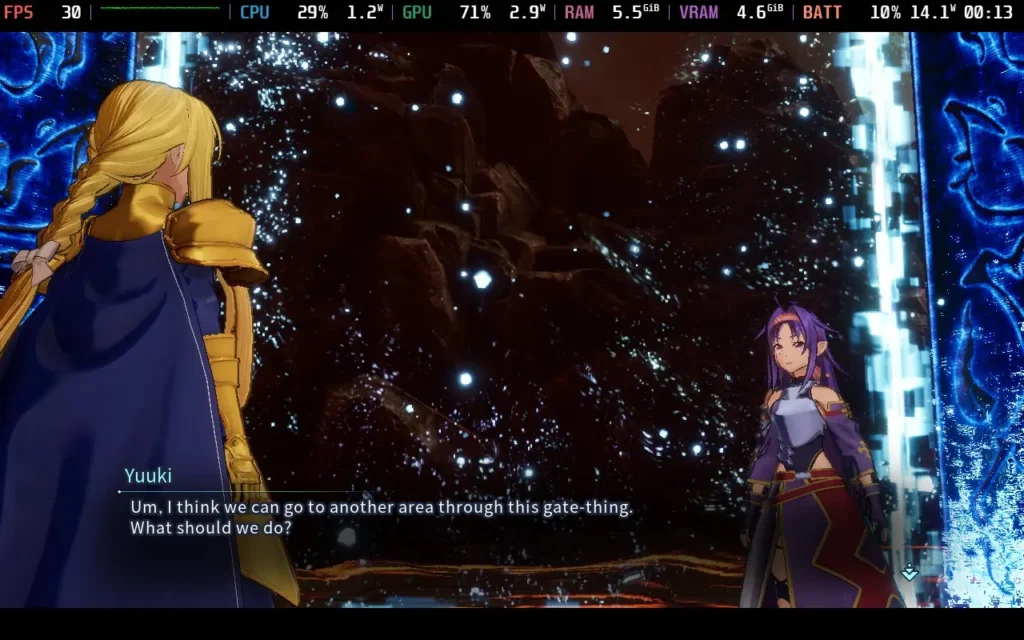
There are 2 difficulty options, "Normal" and "Easy." However, selecting Easy will limit the kind of loot you can get. Normal is easier anyway, so I wouldn't worry about it. I played through the first chapter of the game without coming close to death, and I'm not exactly an expert at these types of games.
The combat in Fractured Daydream is pretty decent. It follows your usual hack 'n' slash formula, and you can abuse button mashing if you want to. There's no requirement for learning combo moves here. To spice things up, you can alternate between light and heavy attacks with your melee characters, and every character has special abilities that you can fire off by using RB + 1 of the face buttons. You can also use an ultimate ability by pressing RB + R3, which deals massive damage.
The variety here really comes from the different characters in the game. While you may have your favorites, you are forced to play various characters throughout the story mode (you can choose which you want in multiplayer modes). Some characters are ground melee and fight as you might expect a normal warrior to fight. However, other characters can fly, while others use ranged weapons instead, turning the game into a 3rd-person shooter.
All these combine to keep gameplay fresh, which could sometimes become monotonous button-mashing. The story mode constantly switches between weapon types, movement styles, and environments, which keeps things interesting, especially since the game's mission structure is fairly similar throughout. Thankfully, the variety of characters, weapons, and environments, plus the frequent story cutscenes/dialogue mixed with the repetitive mission structure, ease the blow.
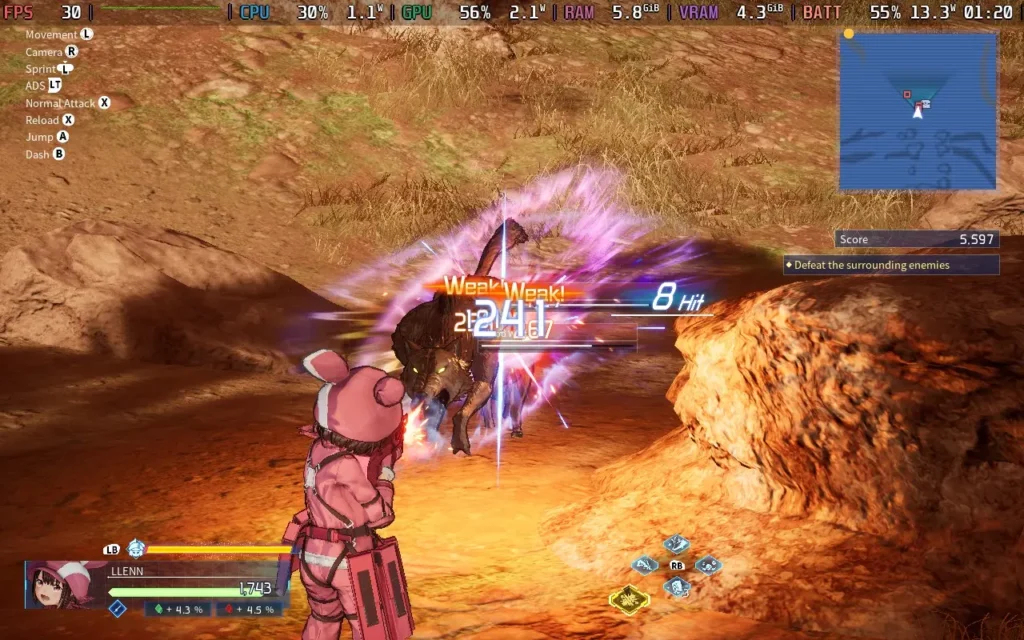
The visuals of Fractured Daydream hold up because of its well-translated anime art style. Even at lower settings, the game maintains clarity and appeal. This, combined with well-mixed sound effects and good voice acting, means the presentation leaves a good impression.
The downside to the story mode is the friendly AI. This is one of those games where your NPC allies are there to draw fire from the enemy rather than do anything useful. The damage they deal to enemies and the damage they take is negligible. Don't expect them to do much fighting for you, but on the flip side, you don't have to worry about them dying on you, either. They are also terrible at pathfinding, so they'll usually teleport to you after a while. This means you can be alone in a combat situation until they teleport.
But all we've talked about so far is the story mode. A big feature touted for Fractured Daydream pre-release was its 20-player online battles.
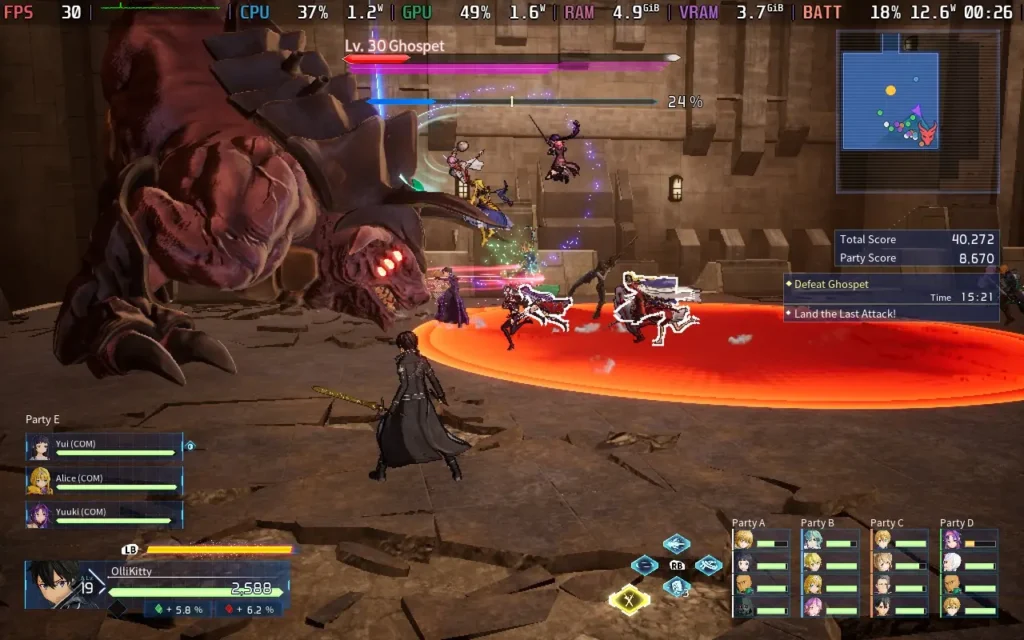
The online play of Fractured Daydream was a lot of fun for me. There are a few different "Quests" that you can embark on, of varying difficulty and location, and on these quests, you'll initially be in a party of 4. Gradually, you'll meet up with 4 other parties to make a combined total of 20 players, at this point, you'll need to face off against the final boss.
It all creates a great sense of cooperation and camaraderie. Even though each party has its score and at the end of the quest, a party will be rated as the "best" party, and you're all still working together to complete the objectives and defeat the boss. It's just plain and simple fun at the end of the day, with no stressing, and no worrying about toxic teammates, this is my kind of online experience. Even if another party member falls, any of the 20 players can revive them, which lets the true cooperative nature shine through.
The only downside to the online game I found was that sometimes the game is overzealous and puts you in a match without 20 human players. Once, the game was matchmaking for nearly 2 minutes, and a full 20-player lobby was found. However, most of my subsequent games only waited around 20-30 seconds, and the player count was usually 5-8 players, meaning some parties were just 1 player. Fortunately, bots will fill empty player slots, and the bots in multiplayer are more competent than the NPCs that "help" you in the story mode.
If you want an even more casual experience, you can go into "free roam" online, which lets you explore a couple of the game's maps with other players. There is also a boss raid mode if that's your cup of tea, although you'll need to play a bit of multiplayer before that unlocks.
Fractured Daydream gets off to a good start. We have proper 1280x800 resolution support, meaning no black bars on the Steam Deck's display, and the game has excellent controller support, which is my preferred way to play it.
We can play with many graphical settings to get the game running as we want, so let's look at my recommended settings.
It's also worth noting that my settings never seemed to save, and when I rebooted the game, the settings would always default to the lowest. I'm unsure if this is a Steam Deck issue where the game is set to always run on the lowest settings on the Steam Deck, but it is annoying.
In SteamOS, I applied a 30 FPS / 60Hz frame limit; there is no TDP limit. As for the in-game settings, we have a solid mix of medium and low across the board to make it look as great as possible while getting as close to a stable 30 FPS.
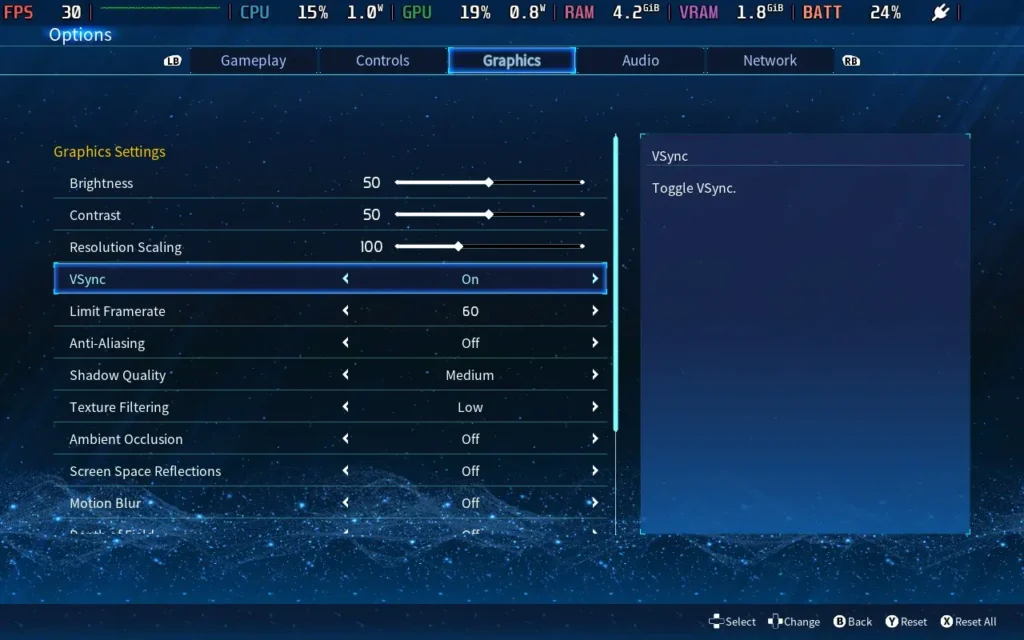
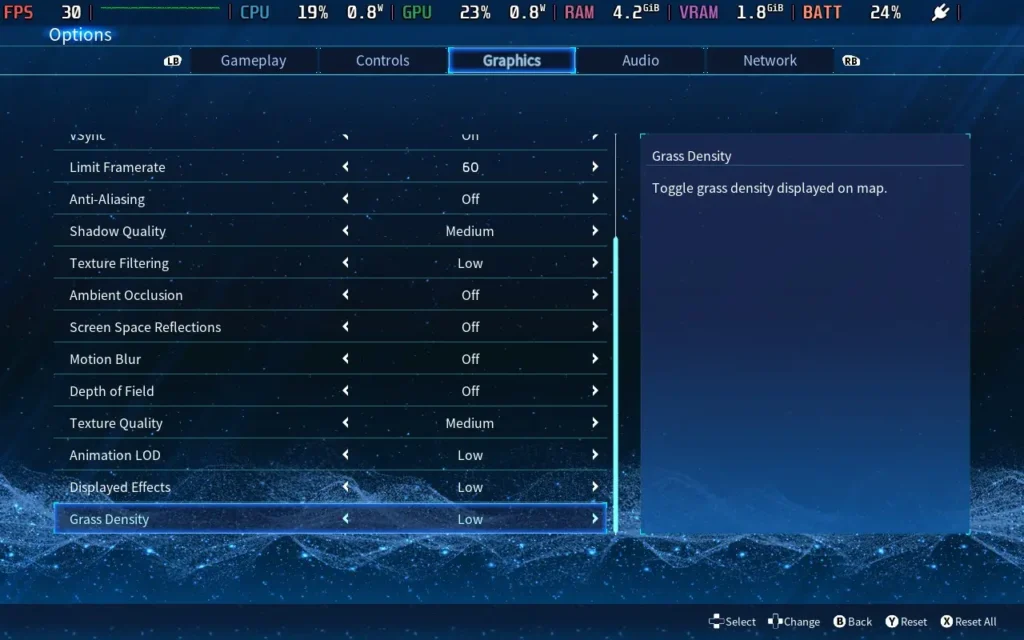
With these settings, we can have an almost completely stable 30 FPS in story mode. Some levels, such as those with dense foliage or lighting effects, have slight slowdowns. For example, an environment appearing in Chapter 2 drops to 27 FPS a few times during battle, but most environments will not drop from 30 FPS.
One problematic environment appears in Chapter 3. It has fog, which lowers the frame rate to the low 20s. Fortunately, it's a rare environment, and the combat areas tend to have less fog. However, this environment does appear in online play in some quests, which can cause issues there.
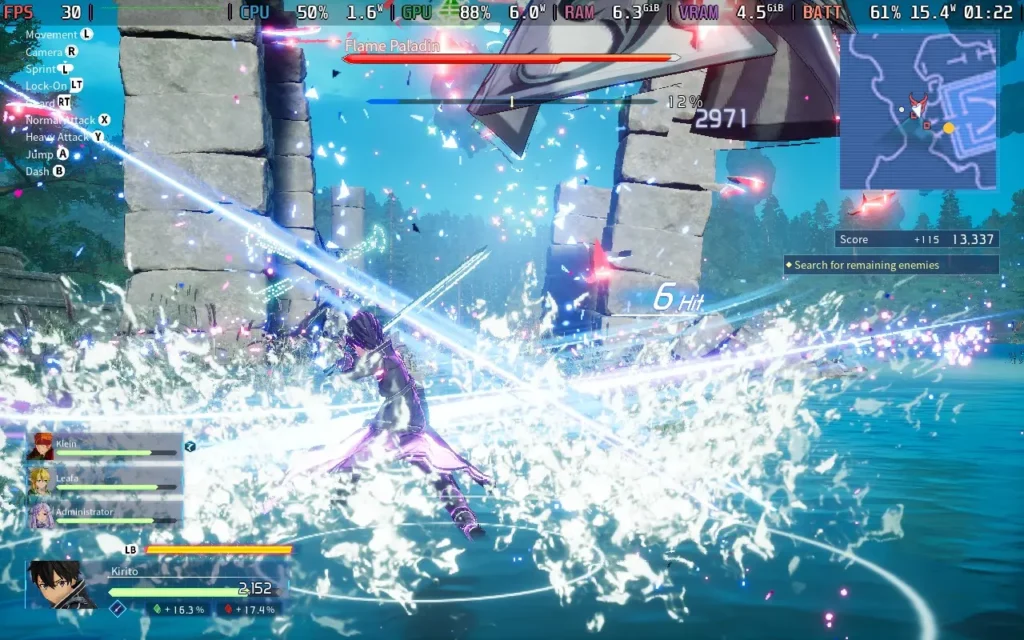
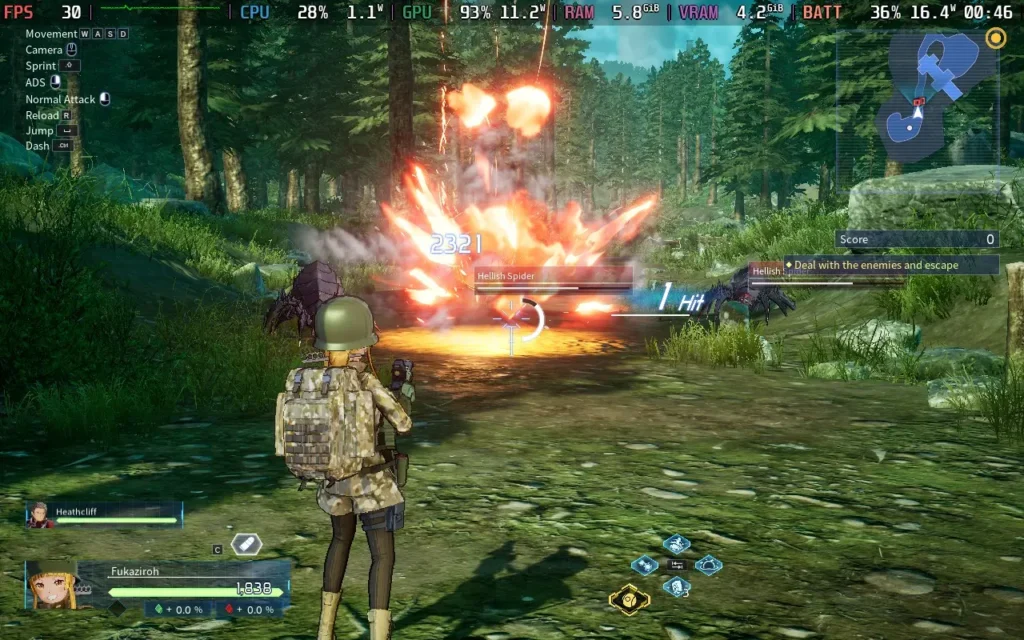
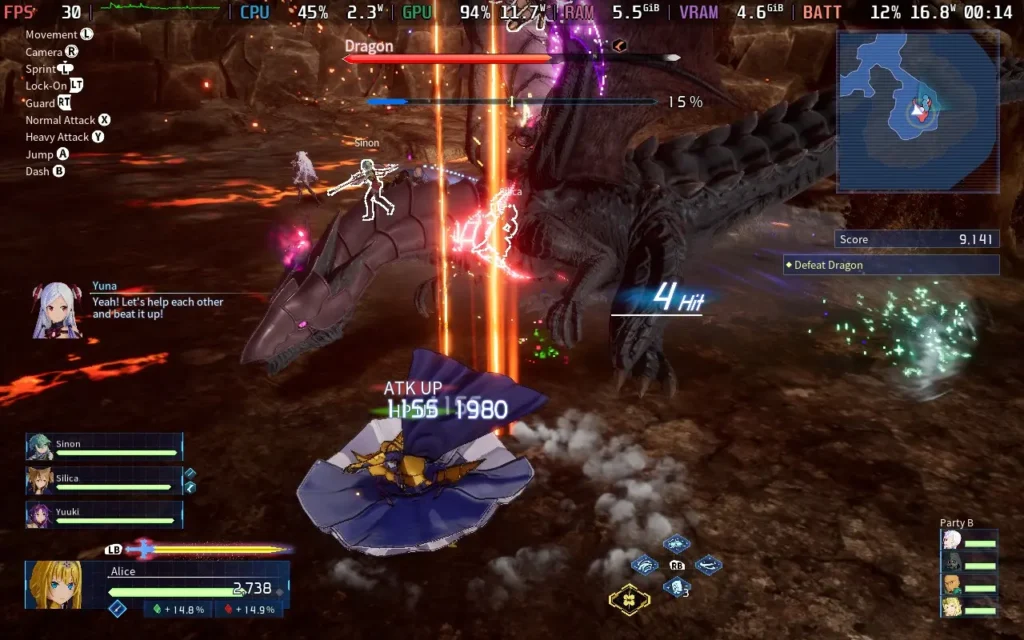
Sadly, my favorite part of the game, the online part, is the worst performing, and you'll want to turn Shadows down to "Low" to disable them. I also set my Resolution Scaling to 80%, which mitigated most of the dips in the frame rate. Even with shadows off and the 80% Scaling, you'll still see dips into the mid-20s when all 20 players are fighting a common enemy.
The saving grace here is that Fractured Daydream is not a game you "try hard" at. It's a reasonably casual experience, so even if you drop some frames, it isn't the end of the world, and it's unlikely to cause you to mess up or miss an attack, as the game is fairly forgiving.
Also, note that this isn't every map. The forest maps are often intensive. However, other maps, especially indoor ones, run at a constant 30 FPS, even online.
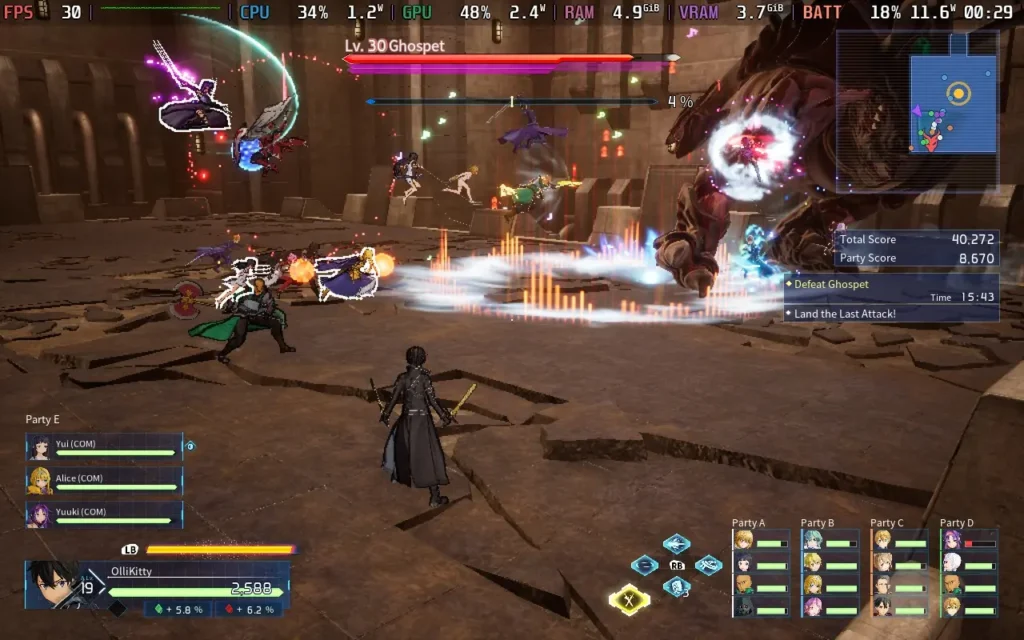
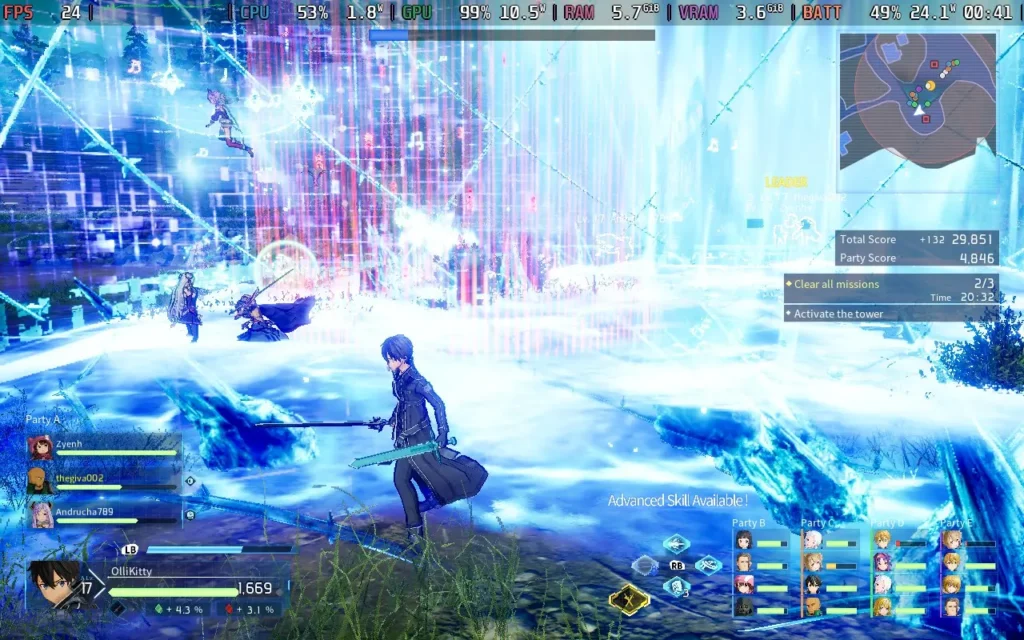
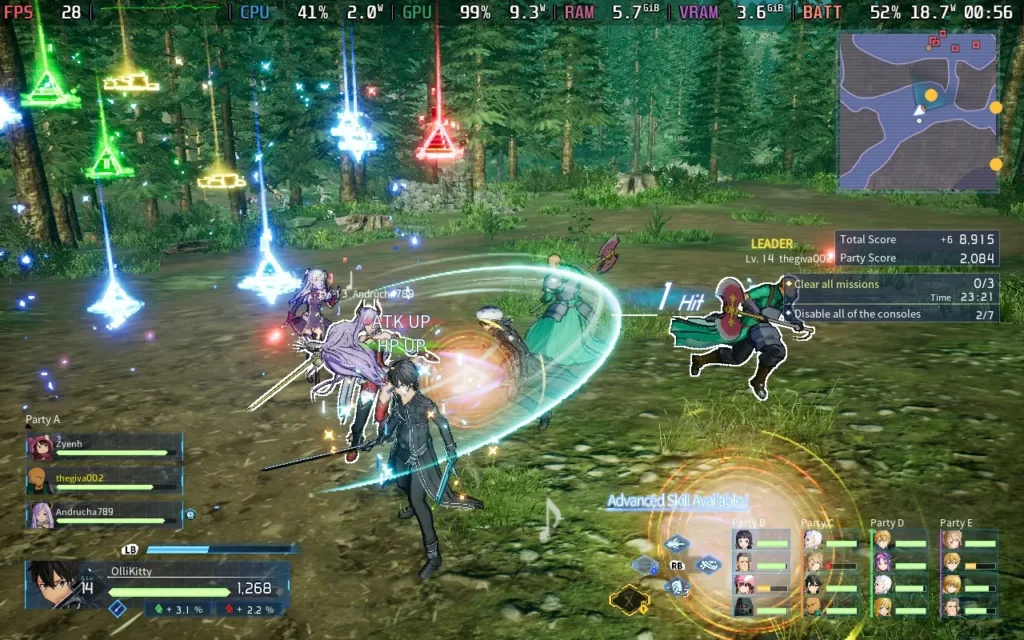
Power draw in the story mode often ranged between 13-18W, with some maps hitting 20-22W on very intensive moments. The online mode tends to stick towards the top end of these ranges. I saw mostly 16-22W during online play, with spikes to 24W. If you're playing story mode, expect 2.5 hours of battery from a Steam Deck LCD and 3 hours from a Steam Deck OLED. Online, you can knock 30 minutes off of each of those.
Temperatures are generally around 65-75C. In the environments that tax the Steam Deck, you can see temperatures up to 80C. The fan occasionally ramps up, but it isn't too bad.
You have a few accessibility options in Fractured Daydream. Namely, you can have an aim assist for ranged weapons, disable the screen shake, adjust camera sensitivity, and whether the camera controls are inverted.
You can also enable English Voice-Overs when players use quick commands in multiplayer, like pinging. This will ensure that the characters speak in English instead of Japanese when giving instructions.
SWORD ART ONLINE Fractured Daydream has a crowd that it caters to and caters to that crowd well, in my opinion. The story mode is designed with SWORD ART ONLINE fans in mind, with references to numerous anime story arcs and characters appearing with sound cues that signify that their presence is significant. Sadly, why their presence is significant isn't conveyed in the game, so your poor reviewer (who isn't an SAO fan) had to go look at a wiki to find out why this person appearing is such a big deal!
Fortunately, for non-SAO fans, the storyline is generally decent, the concept of SAO is easy enough to grasp, and you can sort of figure out what's going on as the story progresses. The gameplay also doesn't disappoint, with over-the-top visual effects firing off in every direction, making you feel like you're using weapons of mass destruction on that spider-looking thing about the size of a large dog.
Performance on Steam Deck is middling, and while the story mode largely runs well, you do have to put up with some pixelation due to the resolution scaling if you want somewhat stable performance in online play. However, the game is fully playable on the Steam Deck, with great controls and acceptable performance.
If you are a SWORD ART ONLINE fan, I don't think it would be a stretch to say that Fractured Daydream might be the best SWORD ART ONLINE video game yet.
Our review is based on the PC version of this game.
If you enjoyed this review, be sure to check out the rest of the content on SteamDeckHQ! We have a wide variety of game reviews and news that are sure to help your gaming experience. Whether you're looking for news, tips and tutorials, game settings and reviews, or just want to stay up-to-date on the latest trends, we've got your back.
Cat Quest 3 was provided by Kepler Interactive for review. Thank you!
This review used an LCD Steam Deck. OLED details will be coming later.
I have seen the Cat Quest games around for the past few years, but never actually took the time to play one. Well, with Cat Quest 3, I finally got my chance. And I have to say, what a delightful little Adventure/RPG this game is.
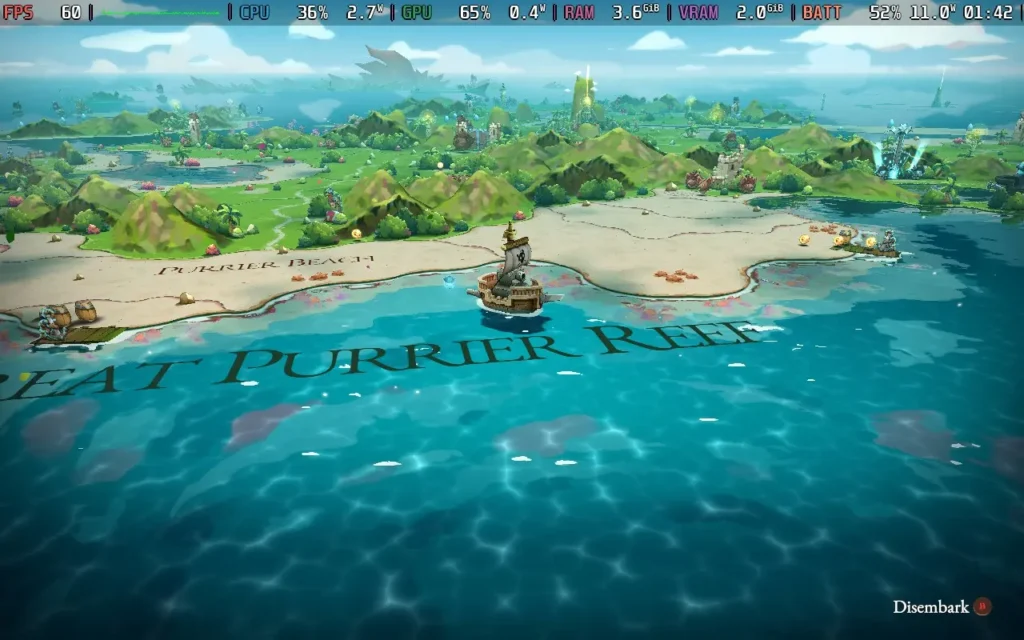
Cat Quest 3 is technically an action RPG, but it kind of feels like an action RPG lite. It's very easygoing, with level-ups simply increasing your stats automatically and occasionally unlocking a new equipment slot. There aren't as many items or abilities as you might expect. Instead, the game opts for a system where getting a duplicate item raises the level of the item, making it more powerful.
While this simplicity and a smaller concentration of items might be perceived as negative in some games, I feel like it works to its benefit. It condenses the feeling of an RPG into a small and delightful bundle. The map is smaller than most RPGs you'll play, there are fewer items, and you won't be sitting there trying to figure out if you should put your points into strength or dexterity.
Despite this, the game still feels deep. You have limited equipment slots for gear, magic, and ship upgrades, meaning that even though there are only a few of each, you still need to decide which ones you want to use. Each piece of gear also generally gives a stat boost, so you can "spec" into health, defense, attack strength, or magical ability, so there are some adjustments you can make to suit your playstyle.
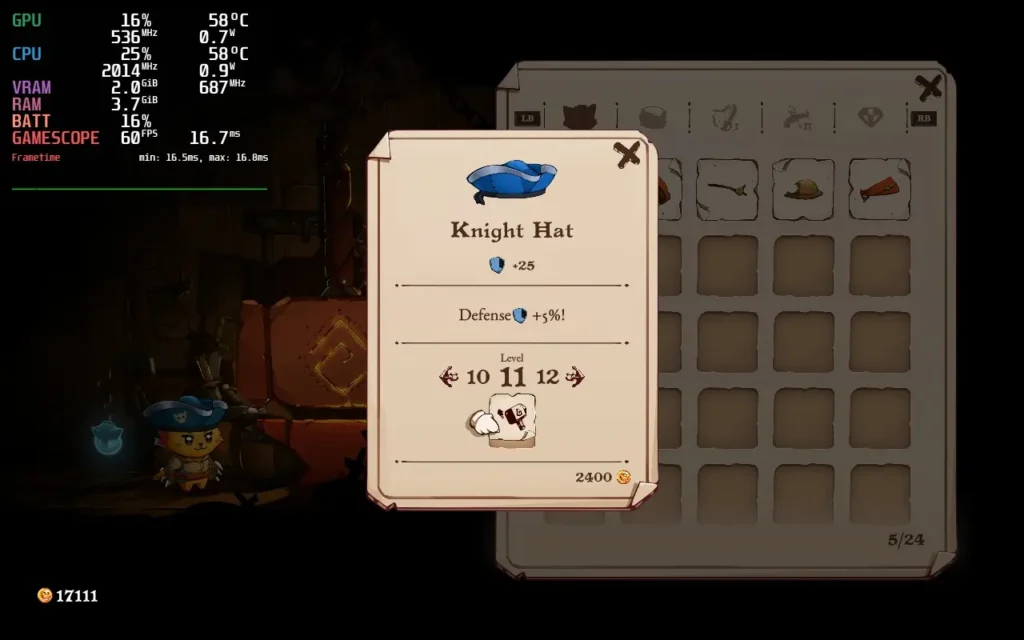
As I previously said, the game world isn't overly large. I'm unfamiliar with the previous 2 Cat Quest games to know how big their worlds are, but in Cat Quest 3, you can sail your ship from one end of the archipelago to the other in around a minute.
Cat Quest 3 is a pirate game, unlike the previous 2 games, which had a more typical fantasy RPG setting. You can get in and out of your ship at any time, and your gameplay will be a fairly balanced mix of using your ship to travel and fight other ships and walking around on the many islands in the game.
While most of the fighting is done in paw-to-paw combat, you get a ranged weapon, which can be good as an initial strike as they tend to be high-damage. Occasionally, you will find it's best to use your ship to bombard a strong enemy from range or deal with a pesky ship that's causing you problems.
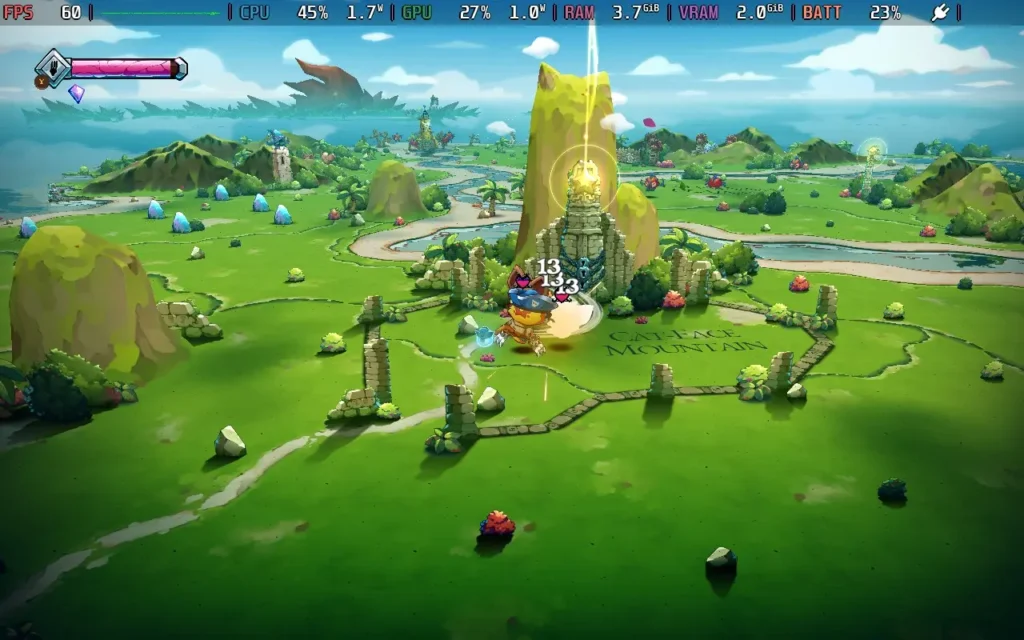
It's not all about the combat, though; littered across the archipelago are its residents, many of whom are looking for help to complete their quests. The game is called Cat Quest 3, after all! These quests can be simple, such as carrying an item from Point A to Point B, or it could be to defeat a certain enemy or find a hidden treasure somewhere. The quests are nearly always on the shorter side, and even the "fetch" quests in the game aren't too troublesome due to that fact.
Many of the islands in the game are also home to puzzles and caves. The puzzles often involve magical rocks, and you have to work out what they want from you each time. Some require you to hit them in order, some require you to hit them in quick succession, etc.
Caves are Cat Quest 3's version of dungeons. They often contain enemies and/or obstacles for you to work through, and at the end, you will likely encounter some treasure, either in the form of a lot of gold and XP or a piece of equipment you can use. Much like the rest of the game, they are shorter and can usually be completed in 5 minutes or less.
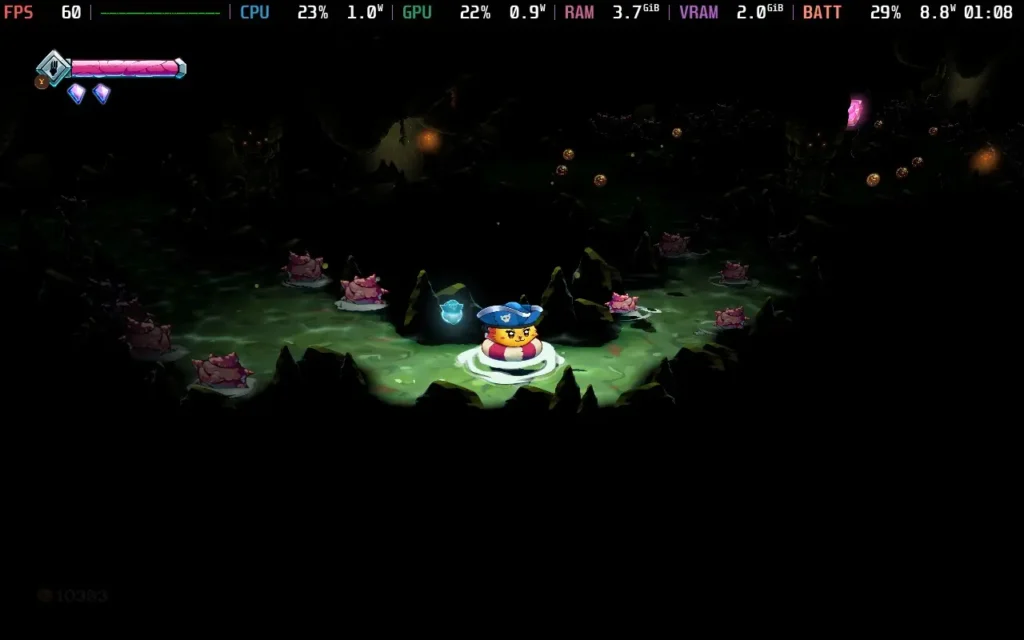
There aren't many negative things I can say about Cat Quest 3. It sets out to be a simplified, cozy, relaxing Action RPG, and it does just that. If I were to pick out an issue I found with the game, it's mostly a bit directionless. Different islands in the archipelago have enemies of different levels, and it can be difficult to determine the next island you should visit. I often found myself visiting 2 or 3 high-level islands and almost dying before finding an island I could handle at my current level. That being said, the game is generally easier if you stick to the correct islands.
The story also feels a little flat. Information is clearly kept from the player from the outset, but this is one area where I feel like the simplified approach didn't help. Things just aren't really explained all that much. The protagonist's being entirely silent also doesn't help matters here, either.
These are fairly small complaints; however, Cat Quest 3 is all about how the game feels and plays, and you can tell that not much emphasis is on the story.
Cat Quest 3 is about as simple as you like when setting it up on the Steam Deck. It defaults to the Steam Deck's native 1280x800 resolution, and the controls work perfectly. The game plays best on a gamepad.
Because of this, I only have one preset.
In your SteamOS settings, set an FPS Limit of 60 FPS / 60Hz and then we'll lower the TDP Limit down to 5W.
There are few graphical settings for Cat Quest 3, just Resolution and Draw Distance. In this case, the Resolution should already be set to 1280x800, but the Draw Distance was set to about half for me. So bump that up to the highest level as well.
Using these settings, the game almost always ran at a locked 60 FPS for me. There are occasional stutters, but nothing egregious. There's not much else to say, really!
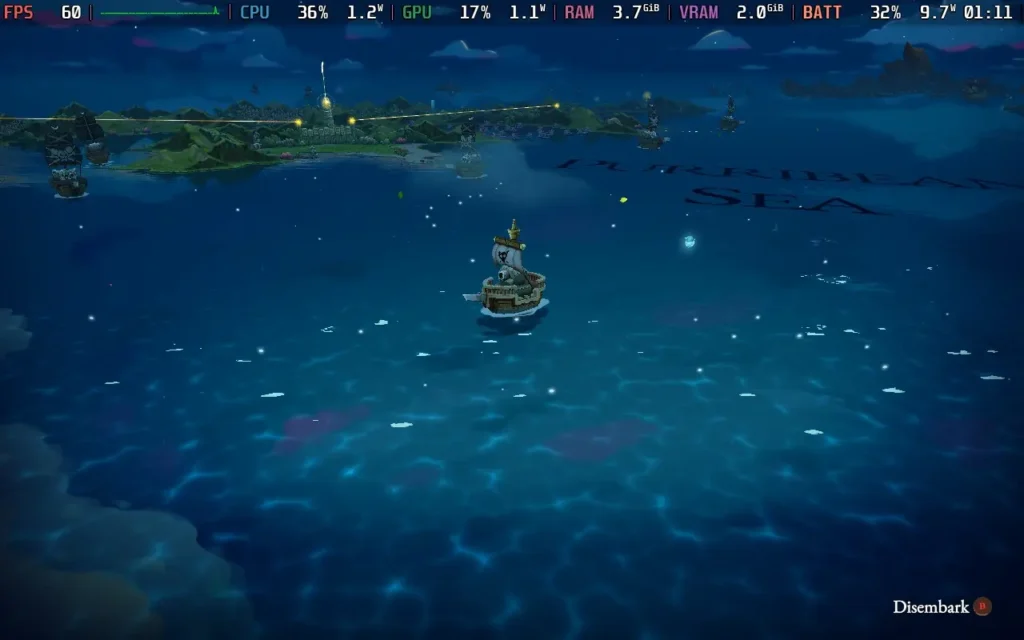

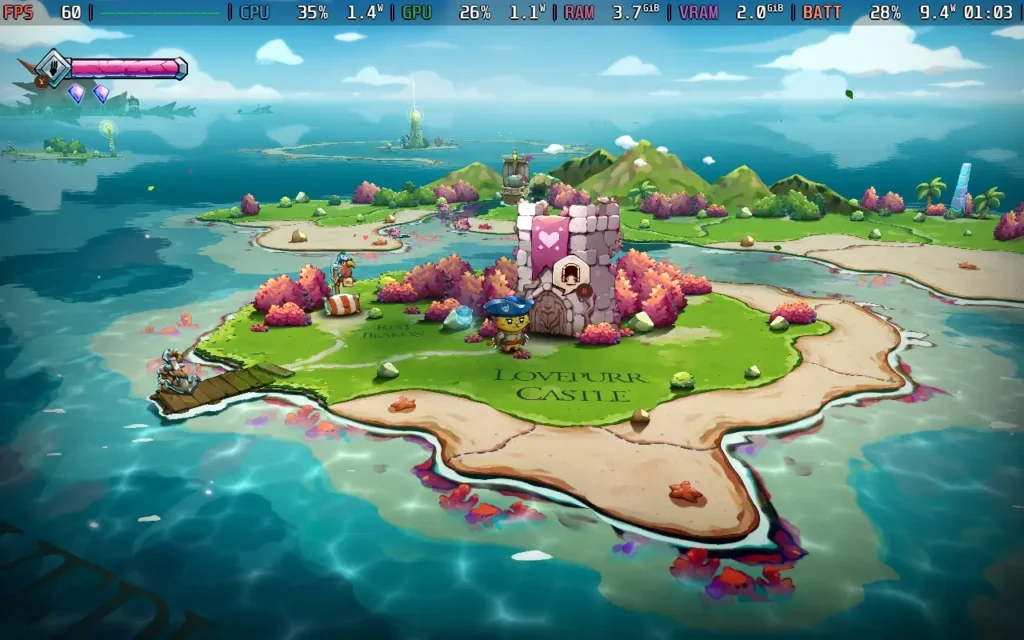
The Steam Deck LCD's power draw stays pretty low, hovering around 8-10W generally, but you can see increases to 11W in "intensive" areas, such as when fog appears. So expect the Steam Deck LCD to get a good 4 hours of battery life and the Steam Deck OLED to get around 5 hours.
Temperatures mostly stuck to about 60C, occasionally creeping close to 65C but never exceeding it.
If you really want to save battery life, you can play the game at 30 FPS with a 3W TDP Limit. However, the power draw still stays at about 8W, so you might get an extra 30-40 minutes of battery life, which isn't really worth it to drop from 60 FPS to 30 FPS.
Sadly, Cat Quest 3's lack of options extends to accessibility options. Other than rebindable controls, there are really no accessibility options. All dialogue is subtitled, though. The game also has an "Easy" mode.
Cat Quest 3 is an appropriately fuzzy-feeling experience. Action-RPG-Lite feels like the perfect label for this game. It's accessible, fun, and about as carefree as you can make a game like this. Children and adults should have no trouble enjoying this game, and it could be ideal for a parent and child to play together.
The game isn't too long, likely following the previous two games, with around 10-12 hours of content here. But for the good times you'll have and the reasonable price tag ($19.99 at the time of writing), Cat Quest 3 is definitely a game I can recommend.
It runs great on the Steam Deck, too. It has a perfect control scheme and very low power draw, meaning you can easily get in long play sessions or hook it up to an external display to play at a higher resolution for some local co-op. Cat Quest 3 deserves our "Best on Deck" rating.
Our review is based on the PC version of this game.
If you enjoyed this review, be sure to check out the rest of the content on SteamDeckHQ! We have a wide variety of game reviews and news that are sure to help your gaming experience. Whether you're looking for news, tips and tutorials, game settings and reviews, or just want to stay up-to-date on the latest trends, we've got your back.
Enshrouded was provided by Keen Games for review. Thank you!
This game was tested with a Steam Deck LCD. OLED testing is coming soon.
Enshrouded is a curious game. It seemed to launch into Early Access with a bang, and yet I had somehow never heard of the game before it launched and was suddenly being mentioned everywhere. The privilege fell to me to try and get this sudden sensation running well on the Steam Deck, and I couldn't wait to see it for myself.
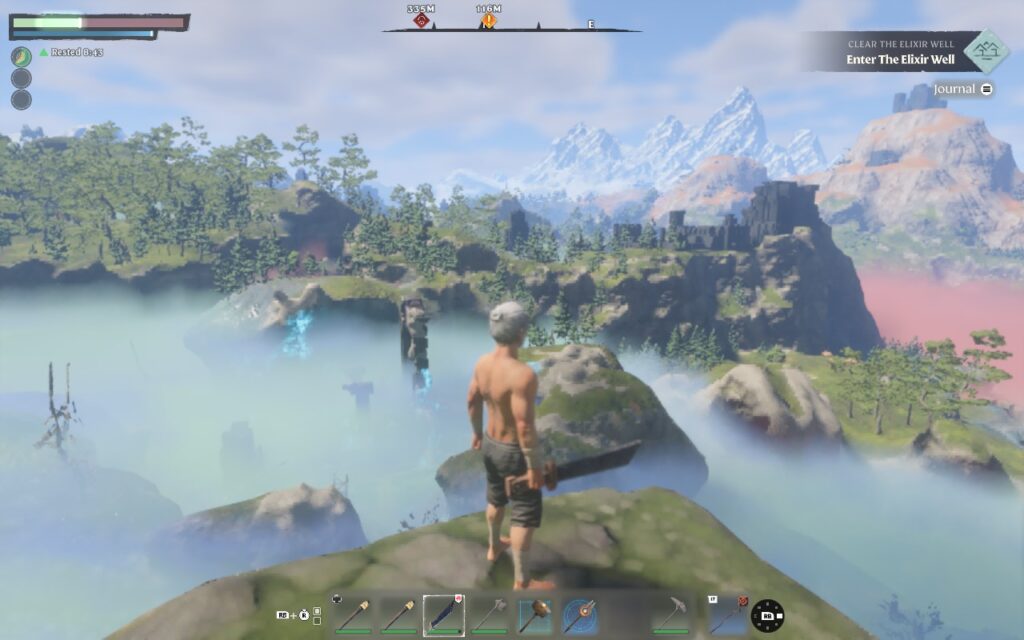
At first glance, Enshrouded seems like a more visually detailed version of Valheim, and in some ways, it is. It takes place in a very large open world, with the ability to construct bases out of various materials and building parts you scavenge, go exploring, craft furniture, weapons, and armor, and defeat various enemies throughout the many biomes.
I like the building system. You can choose from only a few building blocks for each material type, but you can also choose what size you want. This allows you to create structures with more intricate details in them. The structures also snap together well and can alter appearance slightly depending on what structure pieces are placed next to them, making it all fit together.
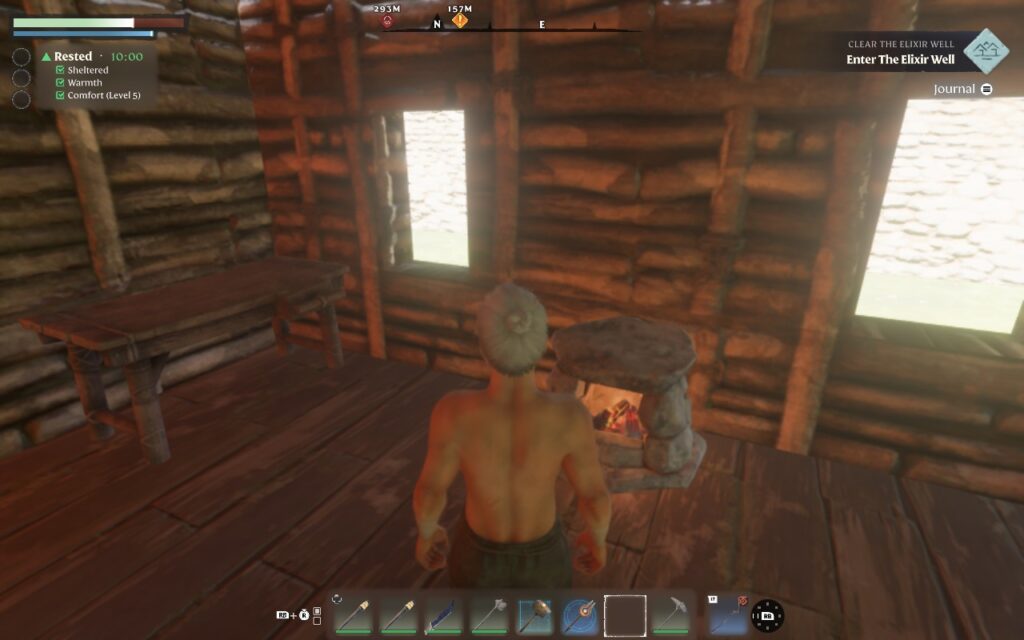
The combat is another plus point and is probably the most fleshed-out part of the game so far. The combat leans more towards the tougher side, and when you're at a low level, most enemies will kill you in 2-3 hits. This means learning to dodge and parry attacks is essential. The movement system allows you to maneuver fluidly while engaged, feeling similar to soulslike combat.
You have a variety of weapons you can use, from melee to ranged, and although it's frustrating when you die to an enemy and respawn at your base, the penalties applied aren't harsh.
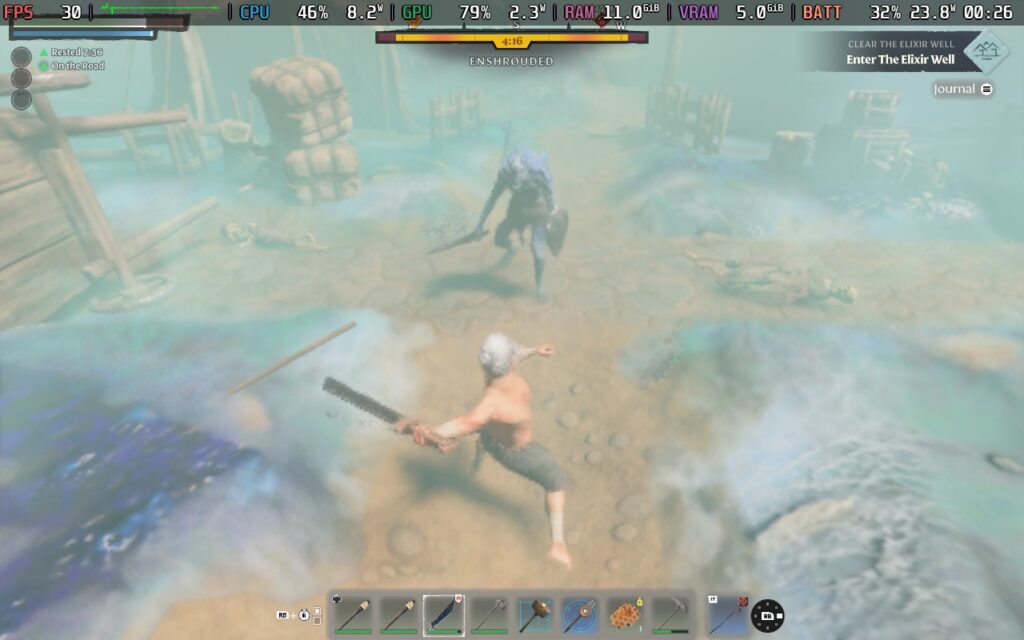
Enshrouded is still in Early Access, and it's fairly obvious to see why. Although the open world is vast and sometimes beautiful, the world is quite empty. There are specific places you are guided to when on a quest, but a lot of the world feels barren currently. While playing, I didn't encounter any friendly NPCs besides ones that can work on your base. It feels like a shame that there aren't friendly villages/towns you can encounter, and I hope something like that is planned for the future.
Another thing that frustrated me is that digging with a pickaxe, for example, can alter terrain by mining. I thought, "Wow, what an awesome feature," but when I quit the game and reloaded my save, all the terrain editing and rocks had returned to their previous state. I understand this might be done to create infinite resources for players, maybe even to prevent grief, but having the feature present and not permanent makes me think they might as well not have had it present.
This is a bit of a common theme, sadly. Whenever you log off and back on, all the enemy and neutral animal spawns restart. Enemies always appear to spawn in the same locations, meaning there's no sense of surprise. You KNOW a wolf will spawn over by those trees, that a group of enemies will be by that ruin. It would make sense if this was a single-player RPG, perhaps, but on a game designed to be played on a dedicated server for 16 players, it feels very strange at how "scripted" and static it can feel.
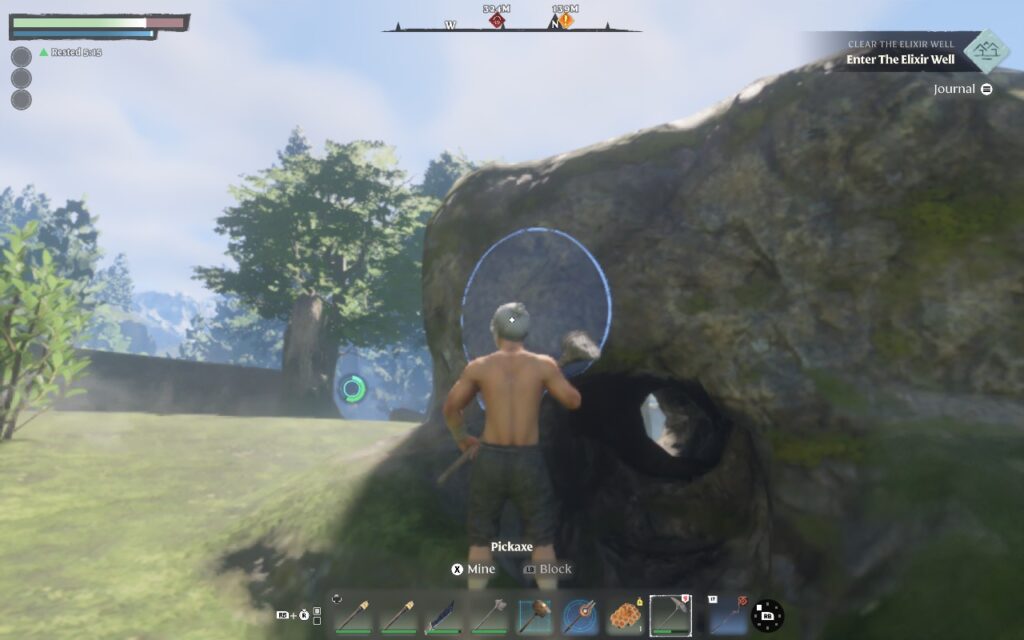
Enshrouded is an Early Access title, and features can change. From a fairly empty open world to some curious design choices, the game has its issues. But does it have potential? Given that the developers have created a game engine from the ground up to make this game, they're in it for the long haul, and Enshrouded could become a fantastic title once it gets fleshed out with more content and polish, a game to watch for sure!
Enshrouded gets the basics right for the Steam Deck, it has full controller support for both menus and gameplay, and it supports 16:10 resolutions, including 1280x800 which is the Deck's native resolution.
However, things start to fall apart a little when we get to performance. The developers have stated that optimization is one of their key concerns right now, as even players using GPUs such as the RTX 3080 have reported difficulties playing the game at decent graphical settings. Unfortunately, that means, for now, at least, Steam Deck users need to make heavy compromises to make Enshrouded "Playable."
Start by setting a 30 FPS lock in your SteamOS settings, and removing any TDP limit, we'll need all the power we can get.
In the in-game display settings, set your resolution to 1280x800 (Native), adjust the Resolution Scale to 65% (520p), and then select the "Max Performance" Quality Preset to set all other settings to their lowest. Ensure FSR2 is your selected Anti-Aliasing method and FSR2 Quality is set to Performance.
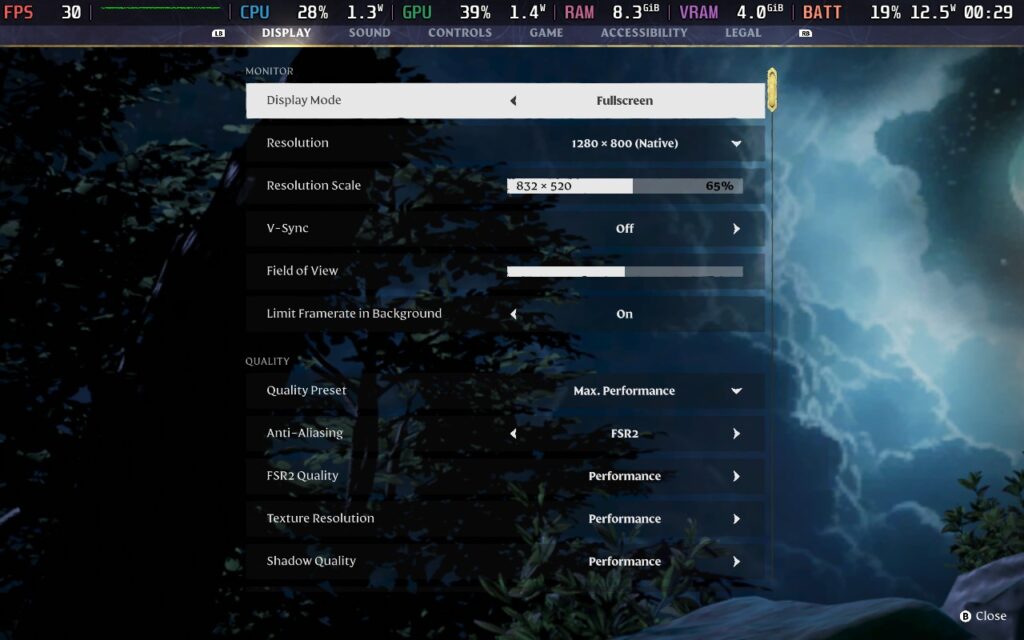
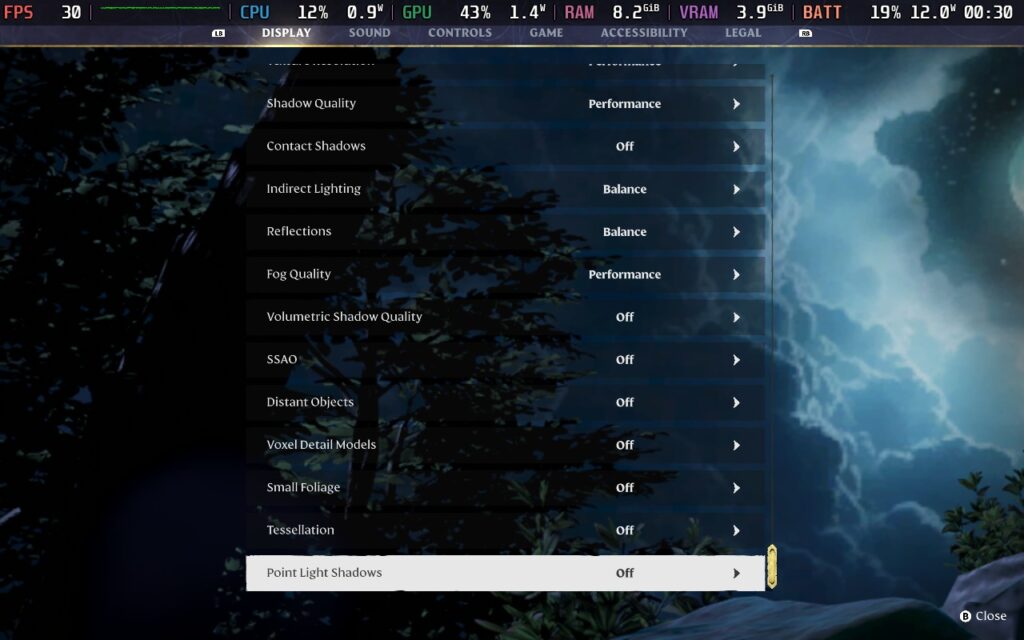
Because we're able to run at 800p and just use the resolution scale, we get to keep a crisp UI with readable text, only the gameplay is reduced in resolution. Performance is mostly steady, often holding 30 FPS, with occasional dips into the high 20s, usually in combat or heavily forested areas, with some minor stuttering.
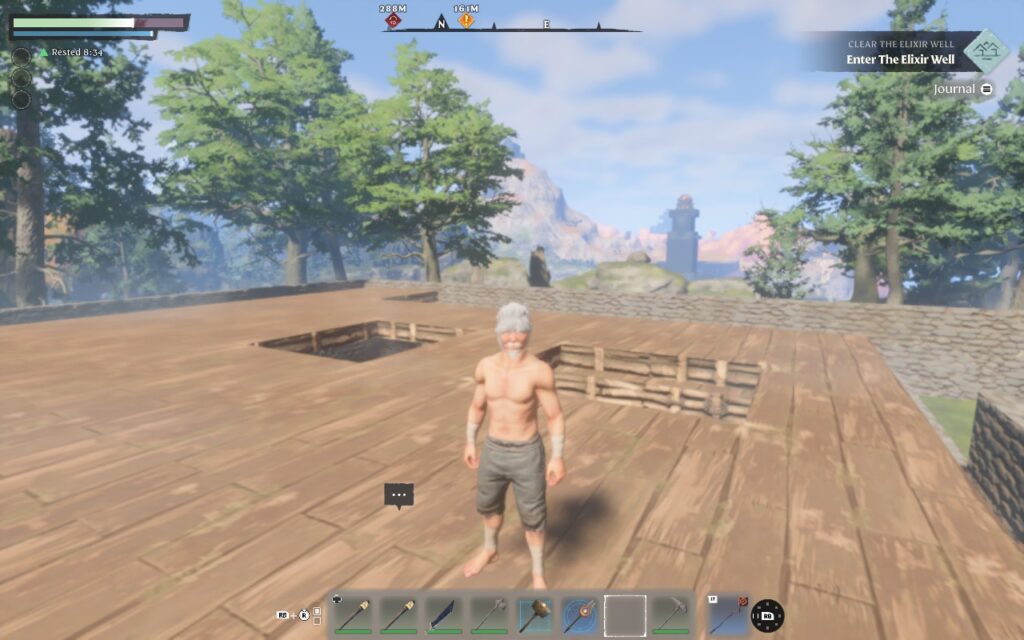
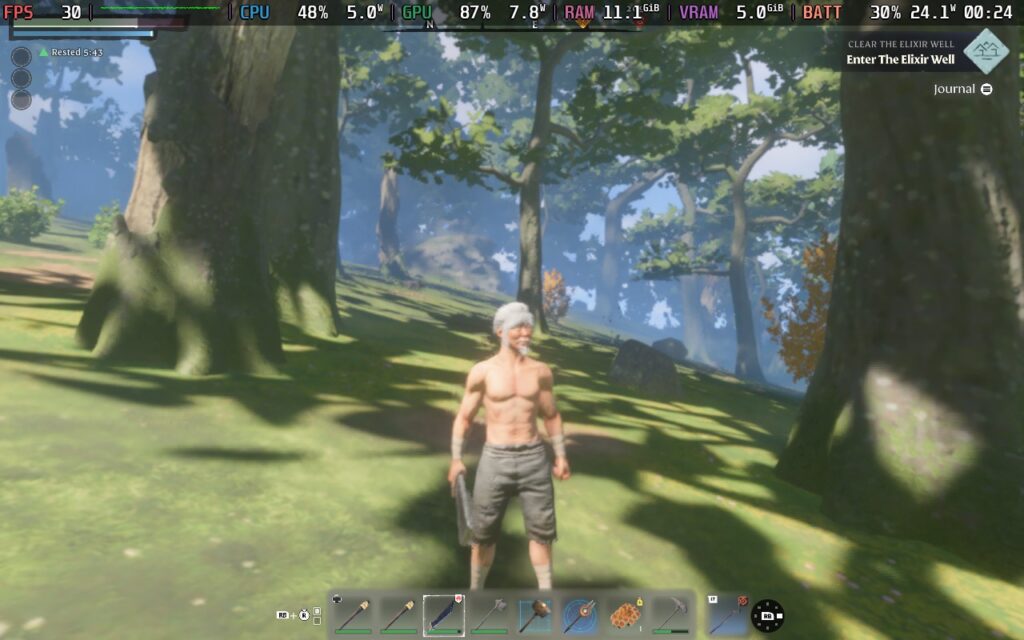
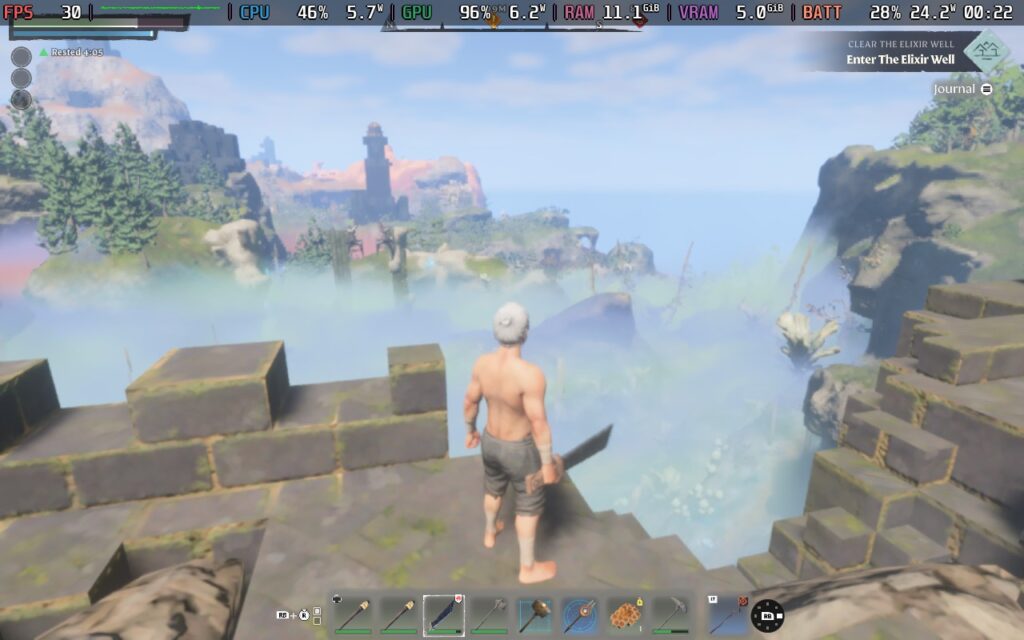
Battery drain depends on where you are. It can be anywhere from 20-24W but tends to lean towards the higher end of that range. As such, I wouldn't expect more than 90 minutes of battery life while playing Enshrouded. Temperatures tended to stay around 75-80C, so it runs a little on the hot side, but that's to be expected given that this game pushes both the CPU and GPU.
Whether this represents a "playable" experience is up for debate. As you can see from the images, the low-resolution scale makes for a very soft image. I would use the Deck as a "secondary" device, where I can log on and do some quick resource gathering or base building but not take on major quest lines or serious combat, as a sudden drop in performance could easily lead to unnecessary death and frustration.
Enshrouded doesn't offer too much in the way of accessibility. There are a few options in the accessibility menu. Most of these are related to how the camera moves, such as removing camera swaying and shaking. There's also an option to add symbols to item rarity, so the rarity isn't just defined by a color, which would be helpful for those with color blindness.
Enshrouded is a bit rough around the edges as of writing this review, but it has the potential to be one of the best survival sandbox games out there. Given the effort the developers have put in to lay the groundwork and the positive reception they've already received, I'm hoping they'll stick by this game and keep improving it until it's a great experience. The combat and base building are pretty much there, but exploring the world feels a little unrewarding right now, and some elements of the game feel very static when a more dynamic approach would have been appropriate.
As for how it runs on the Steam Deck, I'm undecided as to whether or not this is a "playable" game. Before this review was written, Valve declared the game as "Unsupported" on the Deck due to performance issues. Perhaps the game receiving this grading will encourage the developers even more to optimize the game. With a little optimization here and there, we could easily achieve a solid 30 FPS experience and maybe up that resolution, scaling a notch or two.
This game is one to watch, but I'd skip it now if you want to play primarily on the Deck.
Our review is based on the PC version of this game.
If you enjoyed this review, be sure to check out the rest of the content on SteamDeckHQ! We have a wide variety of game reviews and news that are sure to help your gaming experience. Whether you're looking for news, tips and tutorials, game settings and reviews, or just want to stay up-to-date on the latest trends, we've got your back.
Touhou: New World was provided by XSEED Games and OnePR for review. Thank you!
Dive back into the world of Touhou in this fan-made bullet-hell RPG. In Touhou: New World, the boundary between Gensokyo and the outside world have been breached and now, it is up to Reimu and Marisa to discover why. Take down enemies, level up skills, forge equipment, and explore to unravel the mystery as to why the barriers have broken and save Gensokyo, the outside world, and beyond!
Touhou: New World is a fan-game made by Ankake Spa, the same team that created Touhou: Scarlet Curiosity, and while there are some improvements across the board, there are some issues that keep the game from hitting all the marks. Starting with the good, the world is vibrant and colorful with an interesting narrative. The gameplay is tight as well, offering an experience that was regularly challenging, especially at boss fights. It was also a great design to have a healing ability that only had a cooldown and didn't have limited uses. I had a good time during these moments and that's where I felt the game really shine.
Ultimately, the experience is a button-mash though, only really getting to some strategy and needing to expand your arsenal past the "X" button in boss battles. There isn't a lot of enemy variety and I can't say I am a fan of the small slowdowns whenever an enemy is hit. It got me a couple of times thinking the game was slowing down, but in reality, it was supposed to highlight the impacts. The gameplay loop is also a bit on the simple side, so if you are an avid top-down action RPG player, this may get a bit boring in the long-run.
I had an overall good experience, but I wouldn't call it essential. If you enjoy bullet-hell games and want a vibrant one with simple RPG mechanics, this will be one for you. It can be a lot of fun, especially during the boss battles, but it can feel a bid tedious outside of them. Luckily, if you do decide to play, doing so on the Steam Deck will be a good time!
First thing to get out of the way, Touhou: New World's graphics settings are in their own little launcher window called "Boot config", which is a serious pain. While it isn't the end of the world, having the settings integrated into the game is a night and day difference and really should be standard. I also noticed that the game can really only be played at 60 and any framerates below don't feel right.
Outside of that, playing the game can be relatively easy, especially if battery life isn't a concern. But if it is, then the recommended build will be just for you.
Setting the quality to medium, SSAO off, and a TDP limit of 8, we can get a smooth 60 FPS that has a nice 12W - 15W drain, which will give around a 3 hour battery. There were some minor spots where the game dipped below, but it was primarily loading in new parts of the level and not during any specific spots of gameplay or boss battles. This was the best way to experience the game without draining your battery!
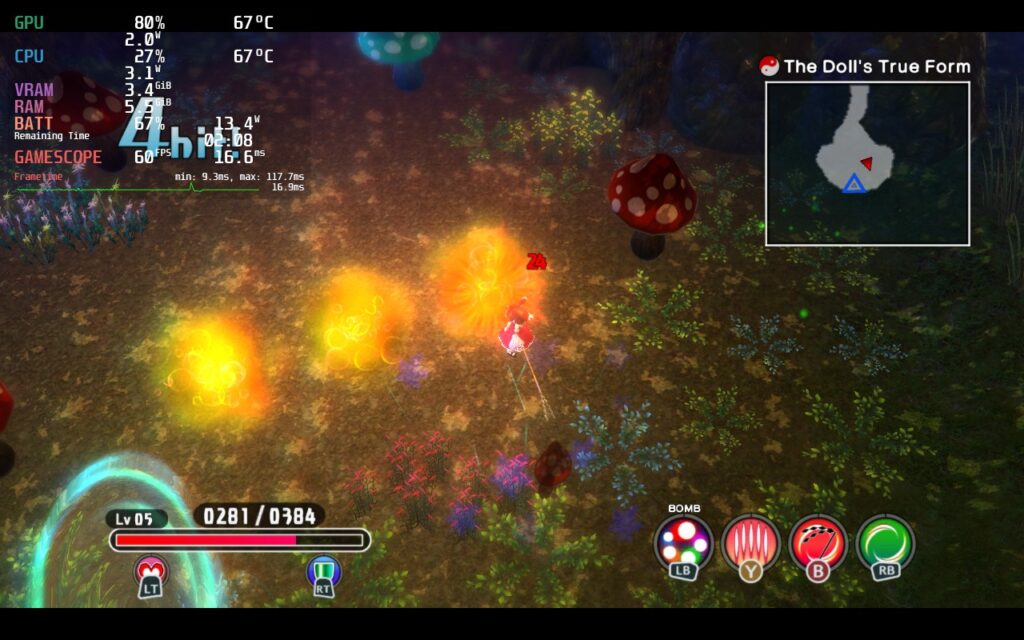
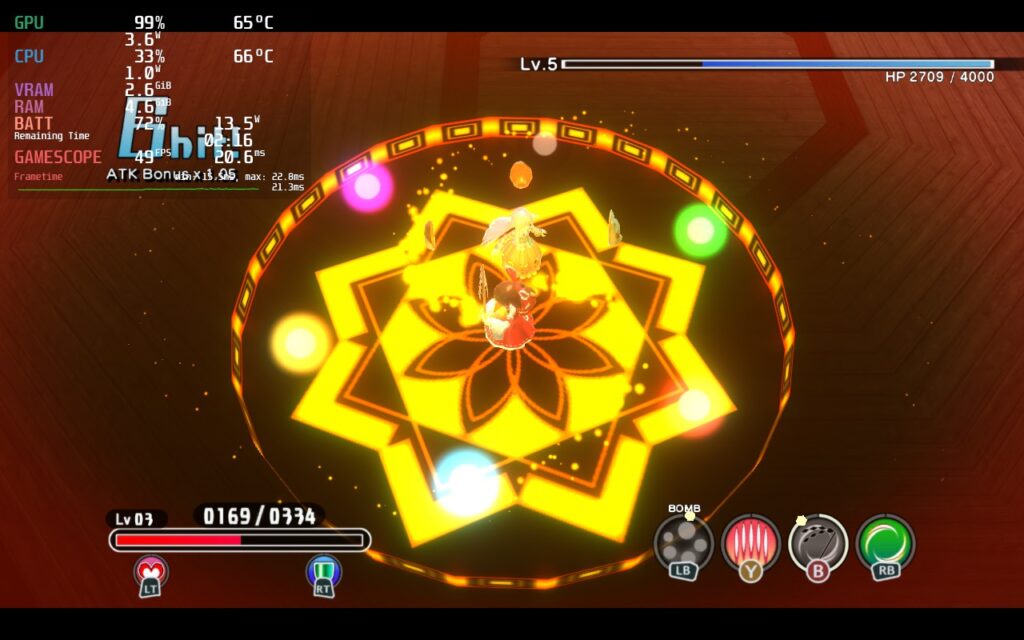
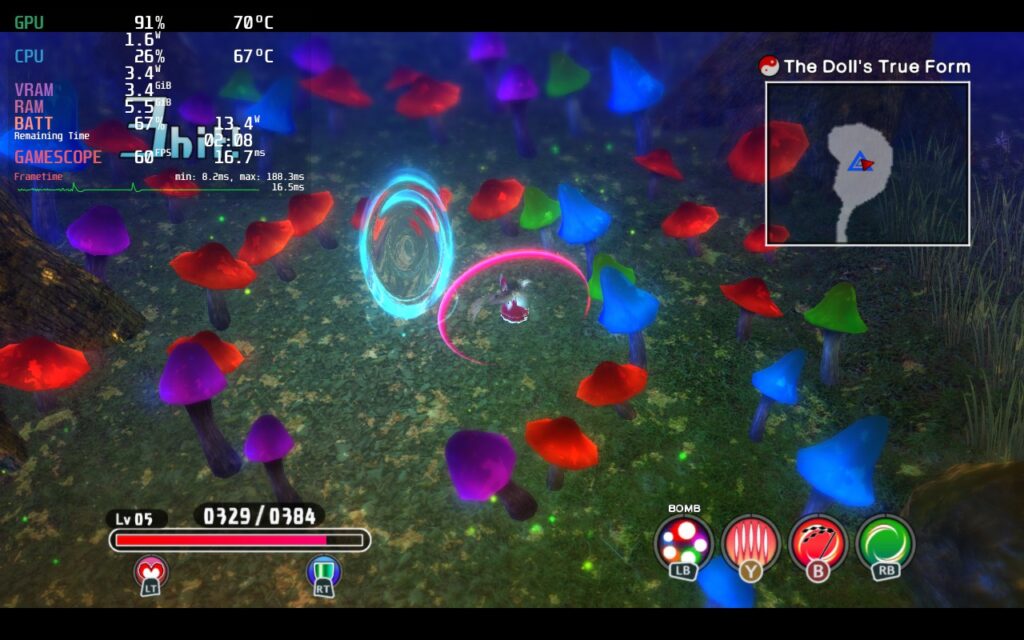
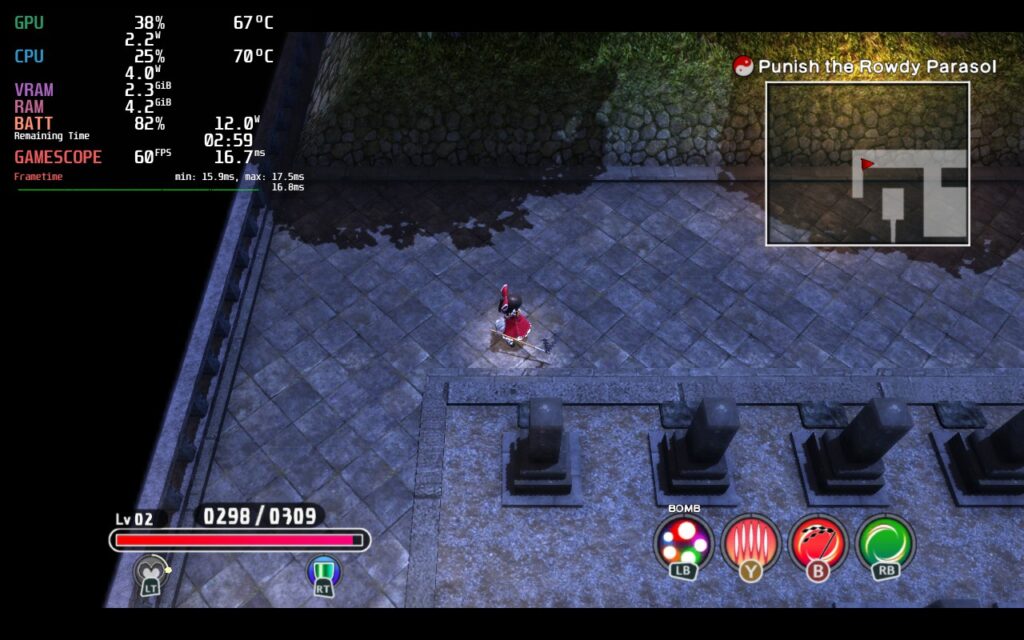
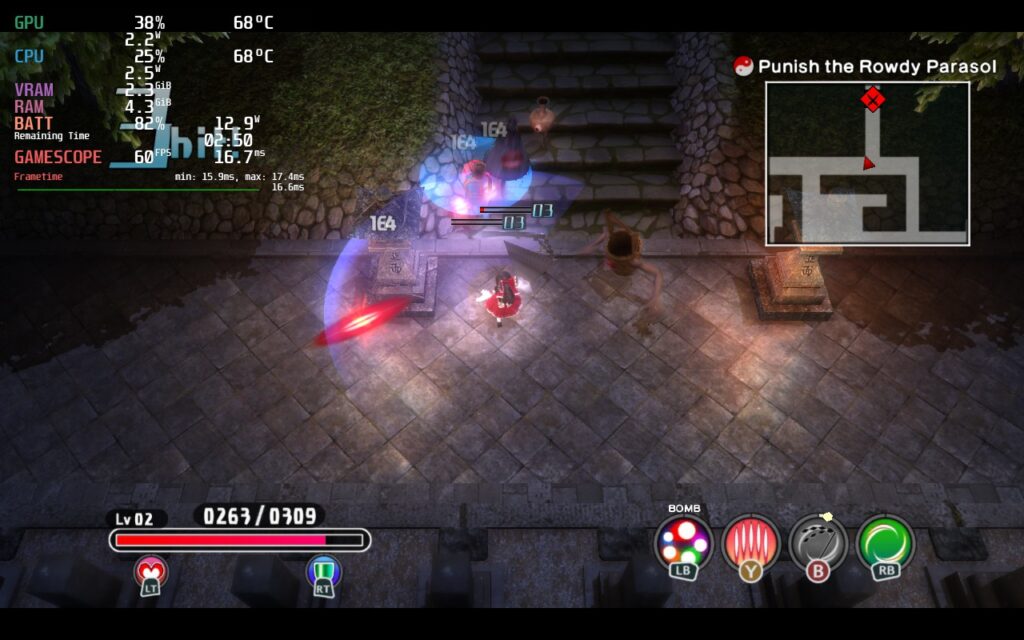
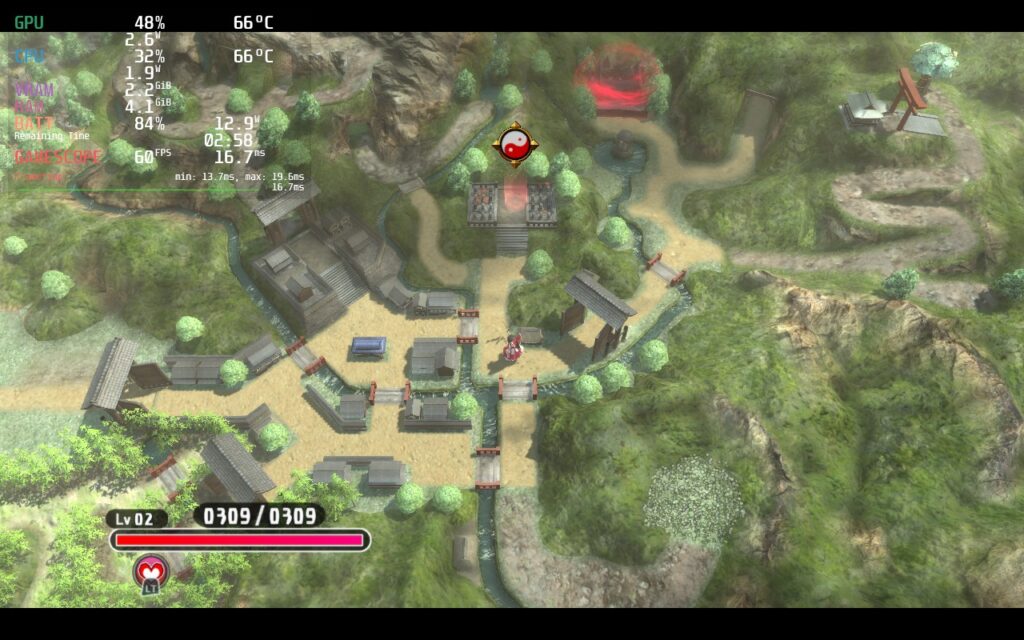
The game defaults to the highest settings and it can be played this way without a TDP limit! Expect drain that can go up to 21W, but if you are fine with that, then no compromises need to be made to enjoy the game at 60 FPS at the highest quality settings.
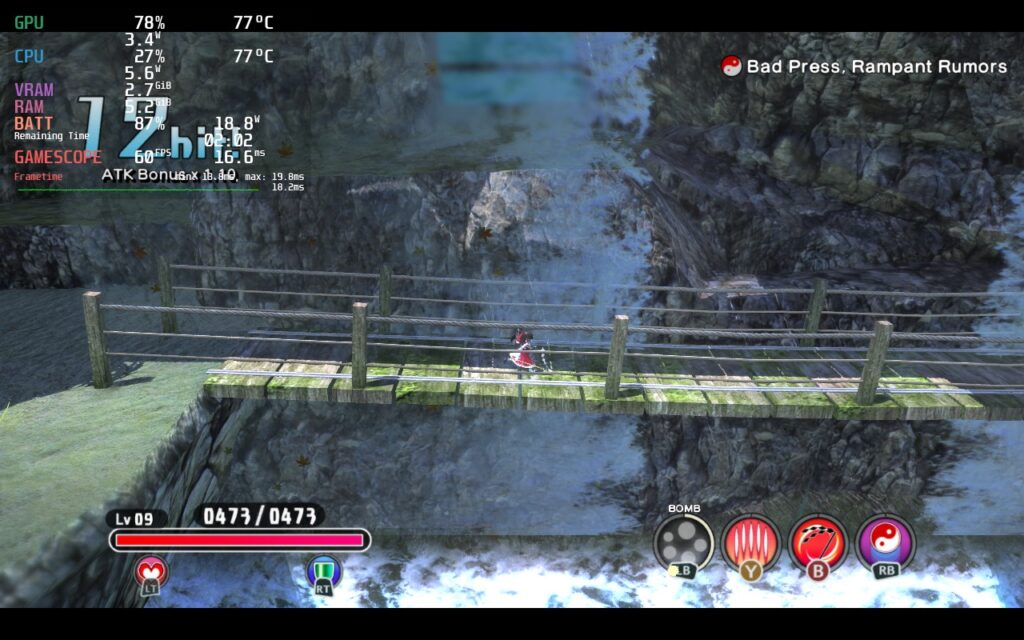
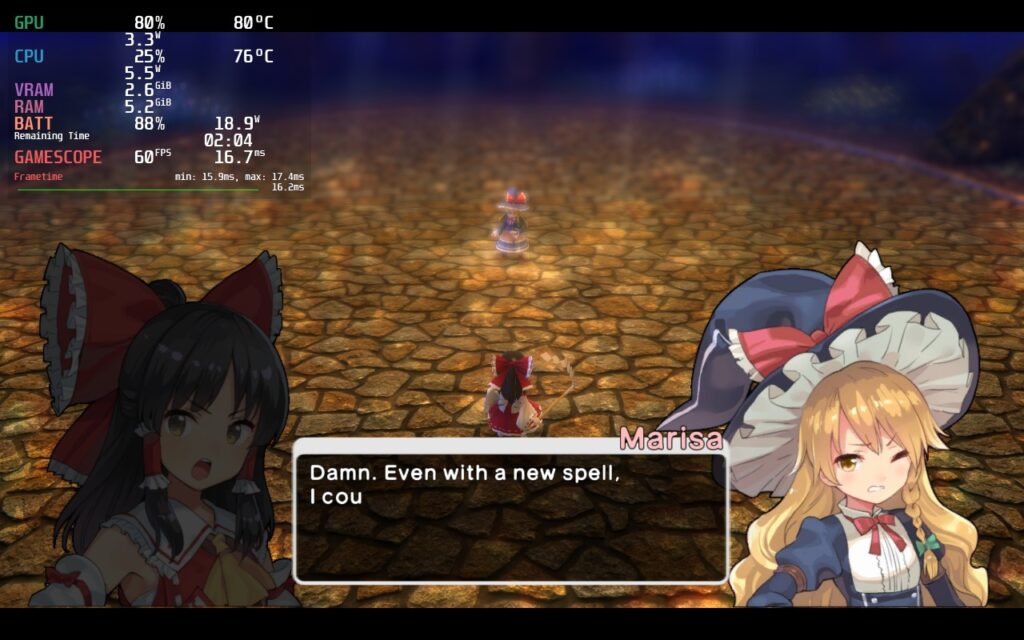
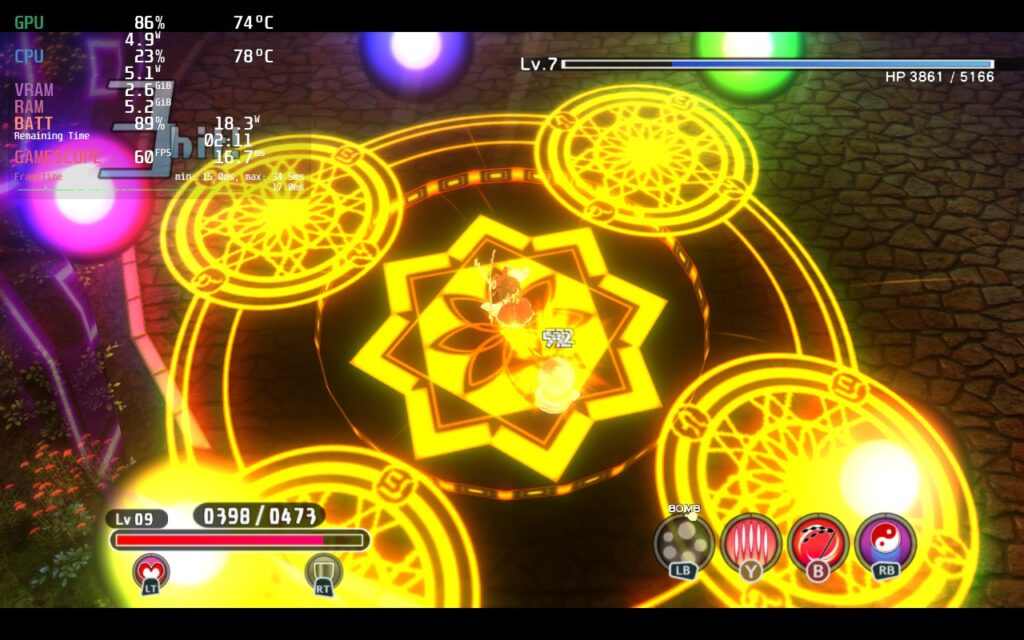
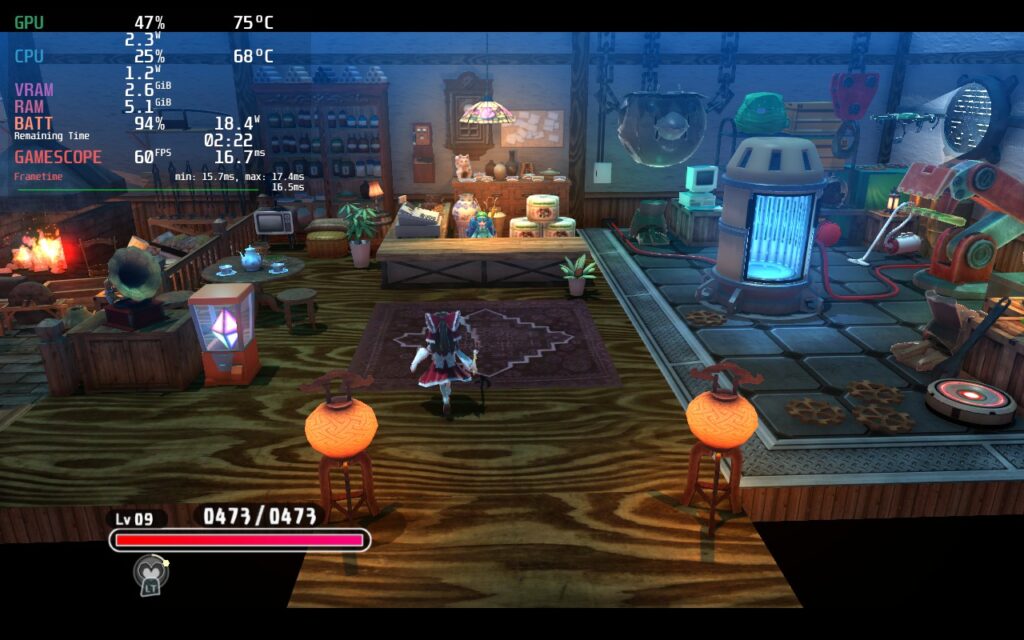
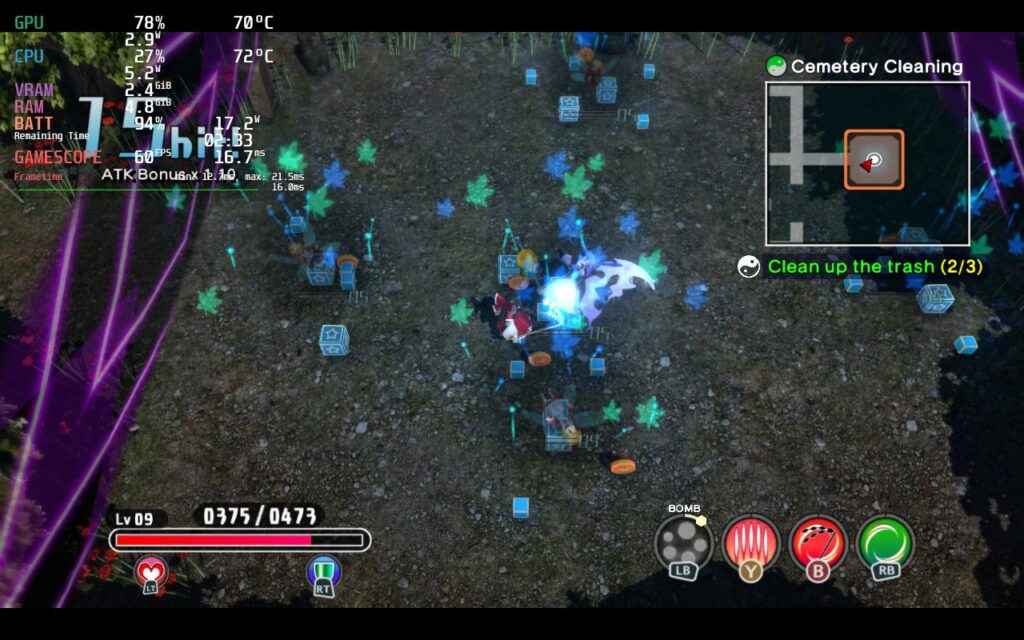
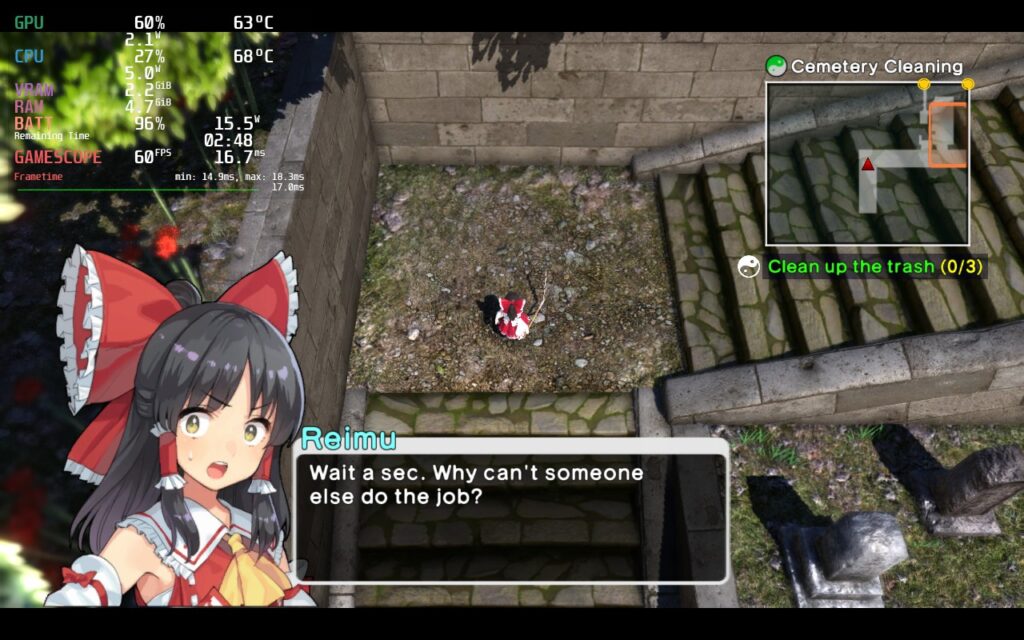
The game doesn't have 16:10 support, so there will be black bars, but it does have full controller and cloud save support. Interestingly, the game seems to use Steam Input, but it has an option in the config to enable it and labels it as experimental. This may lead to conflicts, but the biggest one I had was it didn't show when I took a screenshot, even when it did.
Touhou: New World is an interesting, vibrant bullet-hell that shines when you are locked in energetic, challenging combat with bosses. There are light RPG elements thrown in here to round things out, but at some points it feels a bit on the simple side. Fans of the series will enjoy this game, but avid action-RPG fans may feel this is a bit too simple. Thankfully, playing this game on the Steam Deck is quite easy to do, though having the graphics settings in its own window away from being in-game is not ideal at all.
Our review is based on the PC version of this game.
If you enjoyed this review, be sure to check out the rest of the content on SteamDeckHQ! We have a wide variety game reviews and news that are sure to help your gaming experience. Whether you're looking for news, tips and tutorials, game settings and reviews, or just want to stay up-to-date on the latest trends, we've got your back.
Wo Long: Fallen Dynasty was provided to us by Koei Tecmo to review. Thank you!
From the developers of Nioh comes a new action RPG that will test your skill and resolve. Wo Long: Fallen Dynasty is a new souls-like game from Team NINJA putting you in the role of an unnamed militant in a dark fantasy world. Taking place during the Han Dynasty in China, you will face off against deadly monsters and soldiers using a multitude of weapons, magic, and divine beasts. Attack, dodge, deflect, and demolish your foes and level up at various resting points while getting new weapons and gear to help you increase your morale rank to become even more powerful. Will you be able to overcome the odds and rise from being a nobody?
I have played a lot of souls-like games recently, but Wo Long has hit all the right spots for me. The fast-paced combat, the setting, the story, everything just clicked. I loved the different weapon types and mixing them with strategic spell casting to maximize the damage I inflict. The enemies are devastating and the game is as tough as many souls-like games are. It might be easier than others as I was able to deflect attacks more than other similar games, though I still died more than not, but I really enjoyed it. But now, we get to take a look at how it plays on the Steam Deck.
Before I go into performance, I want to make note that I was told the game was not considering making the game playable on the Steam Deck during development. This means that there aren't many optimizations included specifically to help the game run on Deck. There could be patches that release later on to make the game more playable, but there has been no confirmation yet.
So to start, I decided to try Wo Long at its out of the box graphics and it is not reasonably playable. The game defaults to its "standard" settings, which I would consider as "Medium" with 100% render scale. This ran the game around 20 - 25 FPS for the majority with some dips below and a couple of big stutters. Going to max settings only made this significantly worse with performance going below 20 and not remotely playable. There are some compromises to be made, but if you're willing to take a hit to visual quality, and put up with some performance issues, Wo Long can be played on Deck.
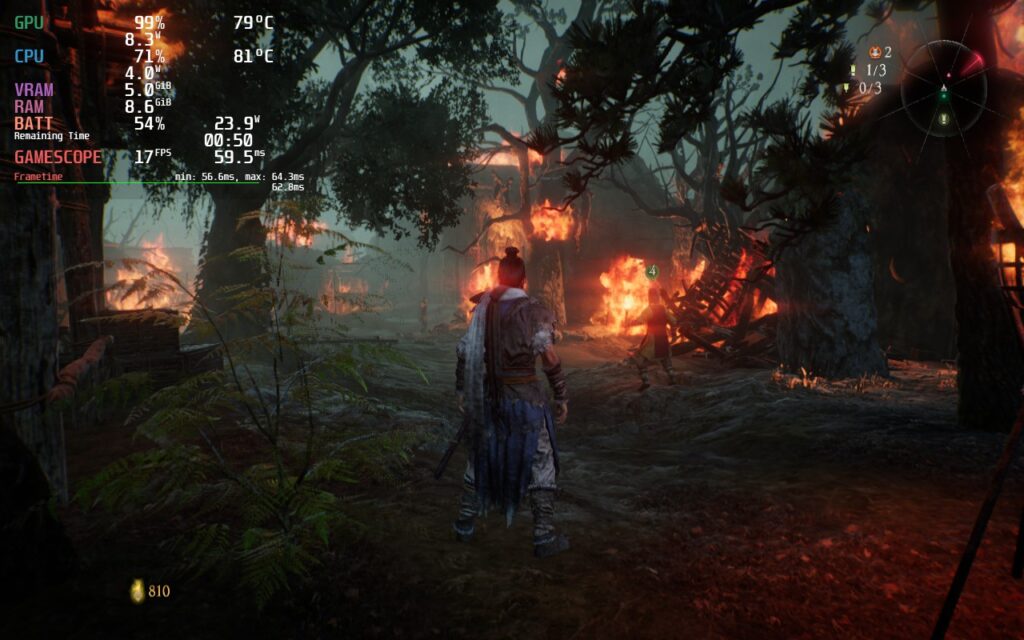
To start, I had to find the source of what's causing the issues. The RAM usage is under 13gb and the CPU usage is under 70% most of the time, but I noticed that GPU usage is generally around 95% - 97%, meaning that's where the hitches are coming from. To combat this, I started by dialing down the visual quality all the way to the lowest possible, which definitely helped with performance. Combine this with turning resolution scale to 60% and prioritizing FPS over resolution and the game is able to hit 30 FPS.
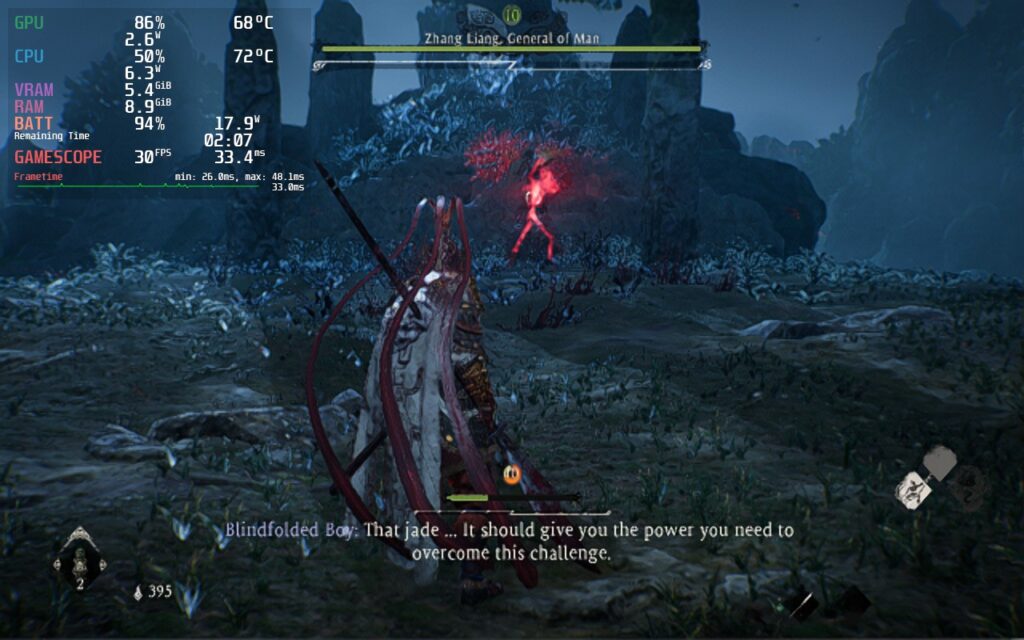
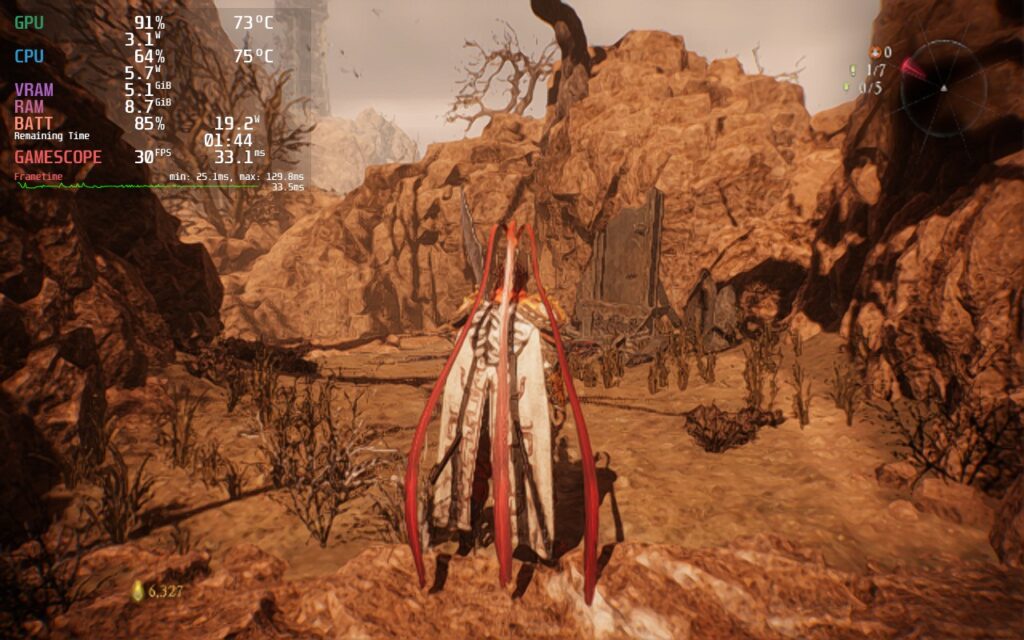
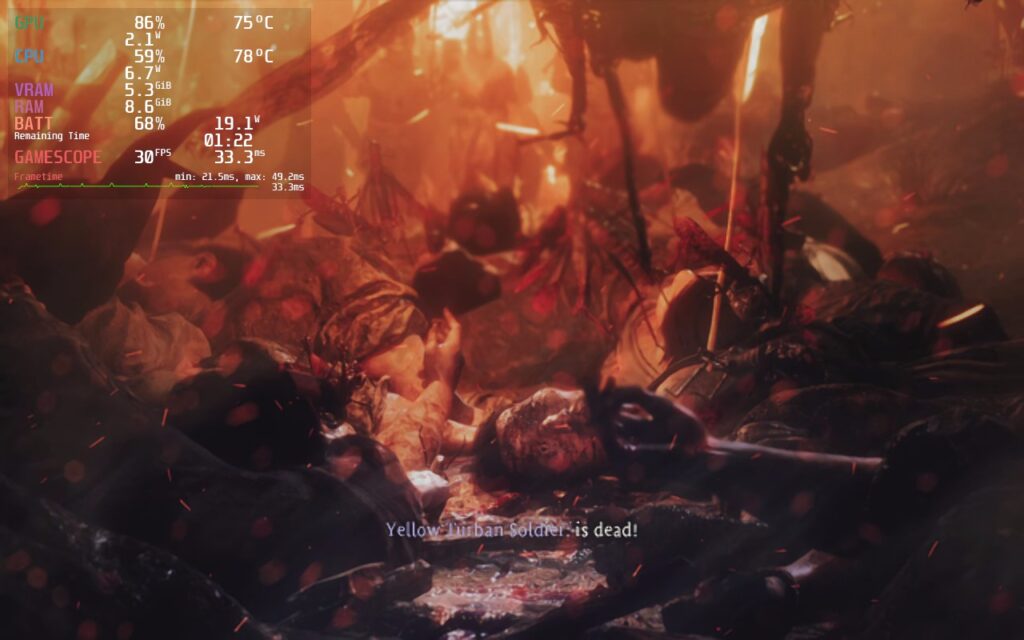
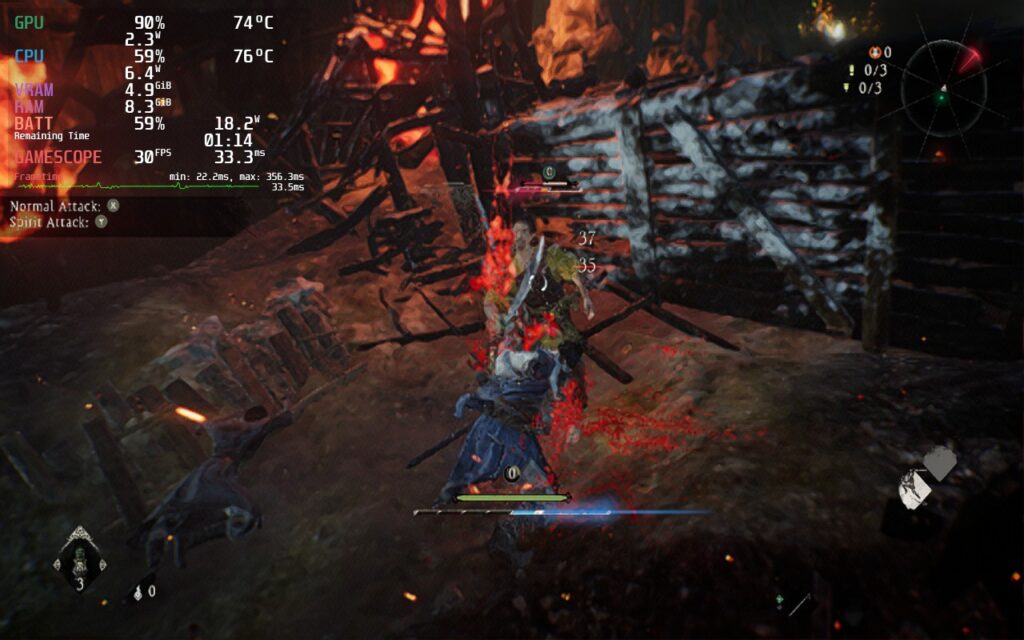
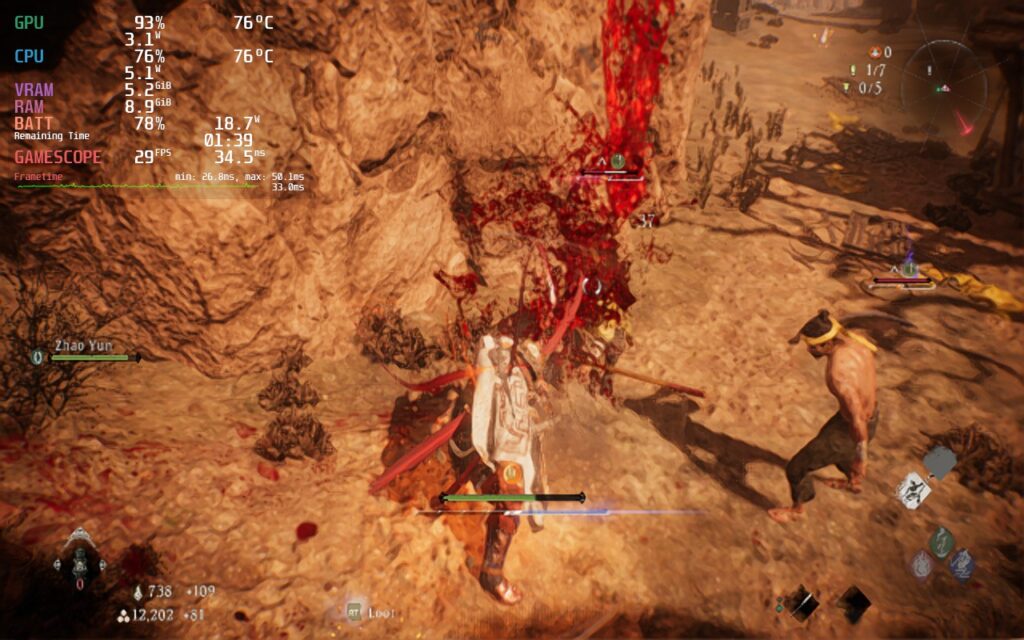
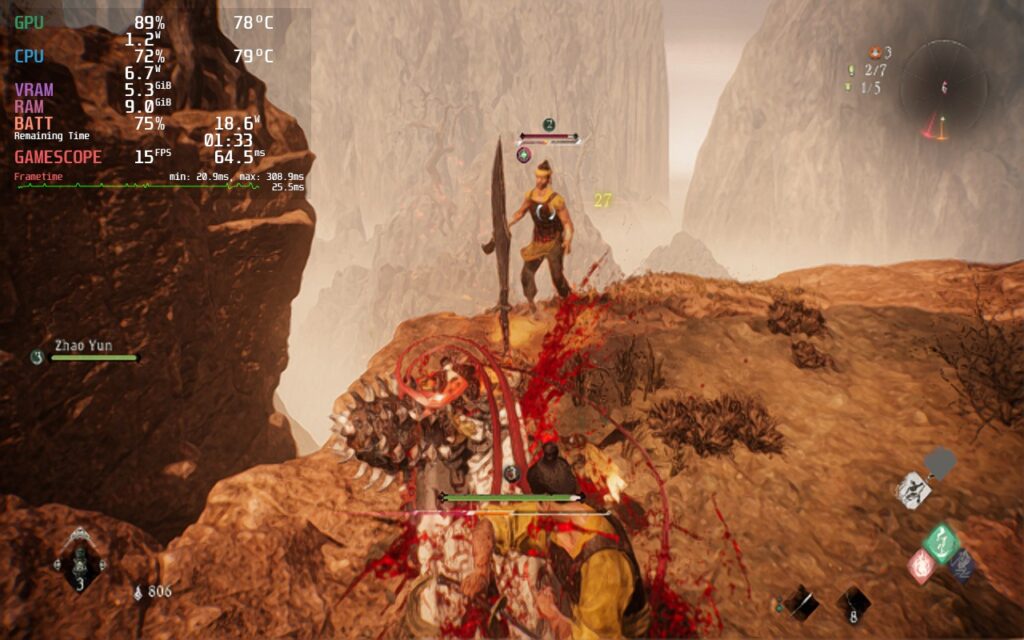
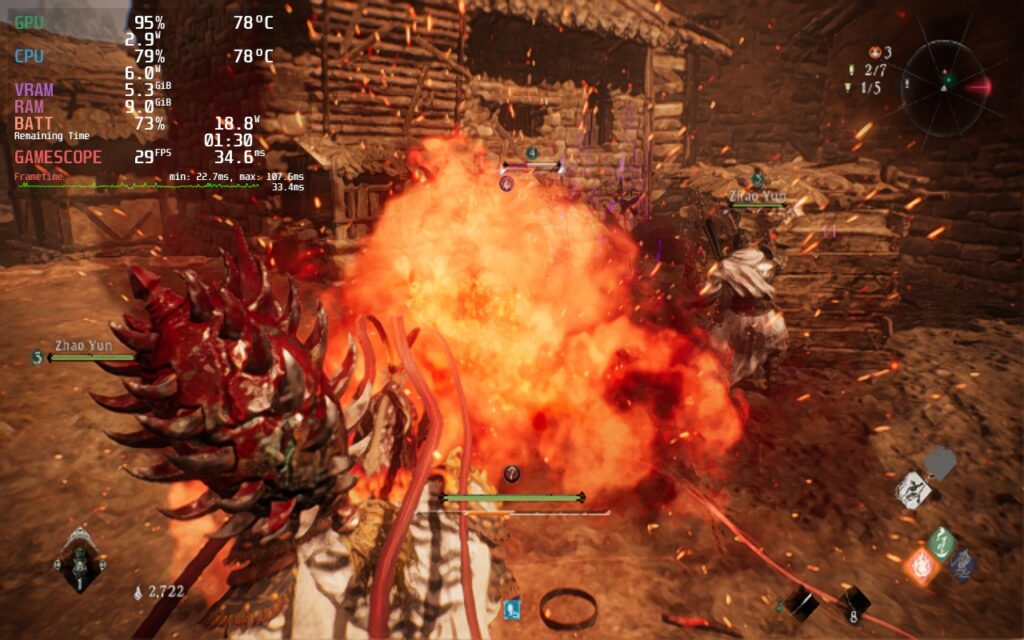
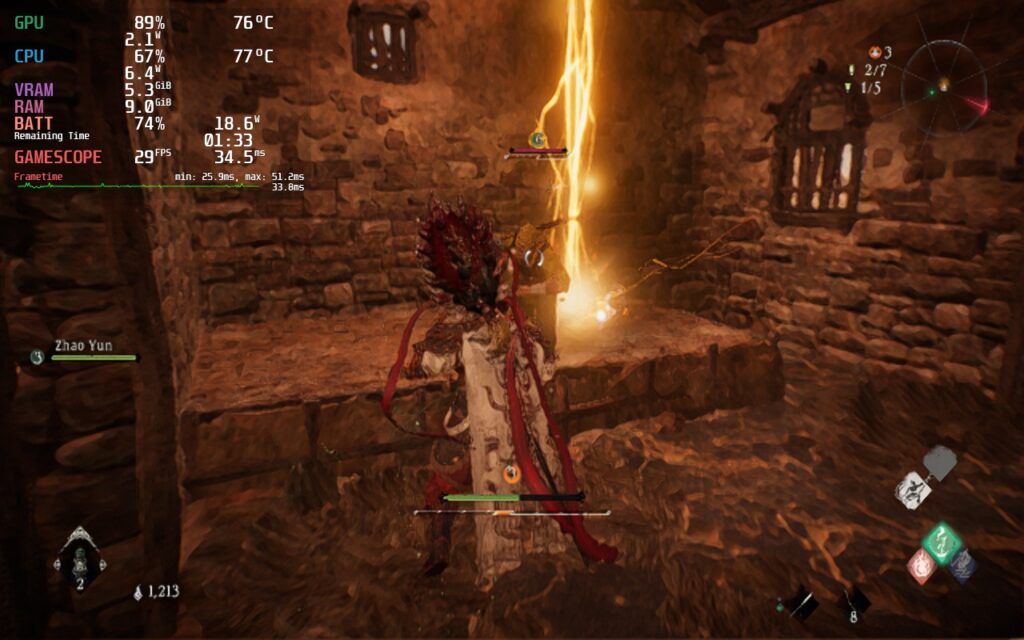
While these images here look not so great, it looks significantly better on the Steam Deck screen. We will still show them regardless, of course, but it will look better on your device.
While playing with these settings, I did encounter some framerate instability and stutters when running through different places or looking at large-scale areas. I wanted to see if I could reduce resolution and that would help, but since in-game didn't have options below 1280x720, I had to force the resolution through Steam's preference settings for the game. After trying multiple, I settled on 800x500, which turned the game into one that fit the entire screen. This also got rid of the major stutters and a lot of the framerate instability I was seeing before, while sticking below a 19.5W battery drain (make sure the internal and external resolution box is checked).
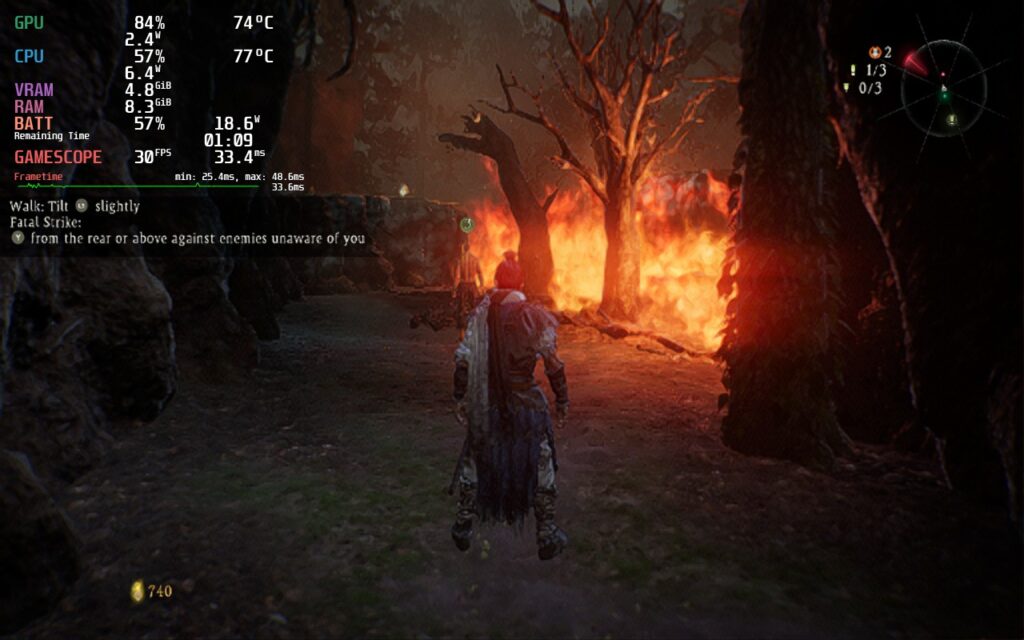
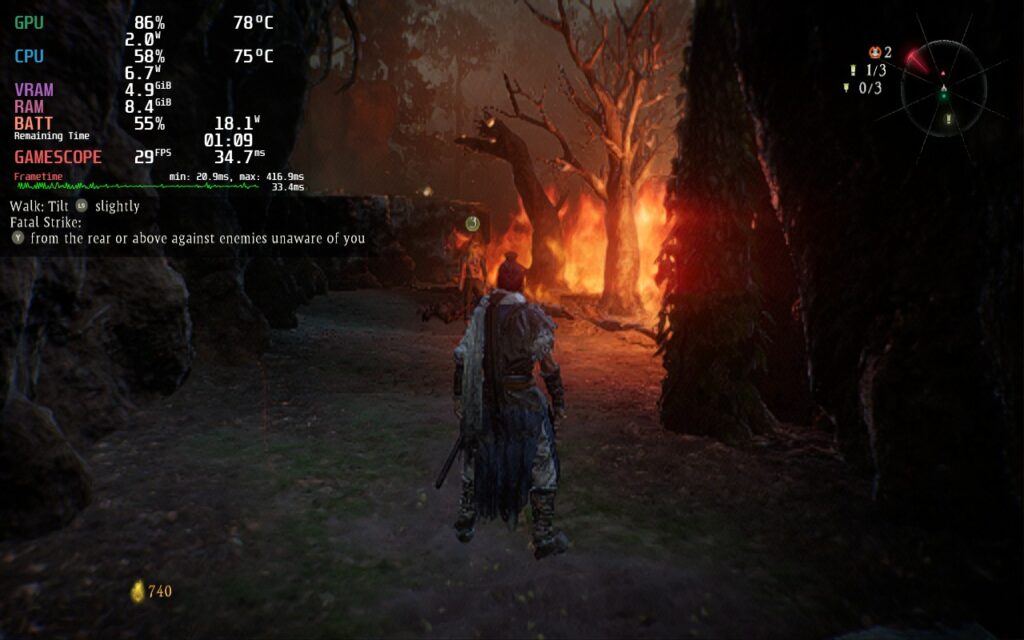
Even though Wo Long is hitting close to 30 without any forced resolution, the framerate bar is much more erratic. This will present itself as noticeable stutters when moving around.
While forcing the resolution is necessary for the most stable framerate, it comes with an odd price. If you force a resolution down from the native 1280x720, you will not be able to navigate down all the way in menus. This really isn't a huge issue throughout most of the game's menus, but it will prevent you from creating your character. For Wo Long, I would recommend playing the game at 1280x720 to start, creating your character, and then after loading in and you can move around, quit the game and change the resolution to 800x500 on Steam.
If you're curious about other resolutions, well the lower one, 640x400, prevents you from accessing even more of the menu and while the one above, 1024x600, let's you access the entire menu, it also creates a horrifying reflection effect among the ground. This effect is present at 640x400 as well, but not at 800x500.
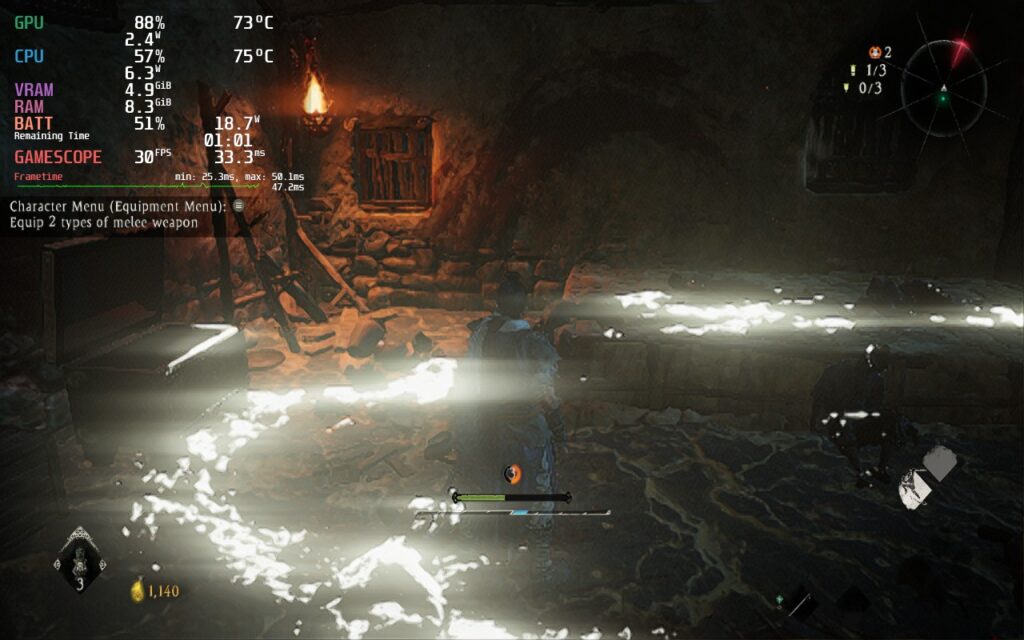
Have I been able to play the game and generally not feel like my timing or experience was disrupted? For the most part, yes. While the game would be amazing running at 40, Wo Long is a brand new game that has decently high minimum specs. I would consider the performance in this case a pretty massive win. I did still encounter weird issues from time to time though.
The biggest one I have seen so far was actually during the first boss. I fought him...over 50 times (because I am not good at souls-like games) and while 49 of those times felt perfectly fine at 30 with some very minor framerate drops to 28 or 29, which I didn't feel, 1 time stood out. During the second phase of the boss, after I had landed a critical strike, the game went down to an average 15 - 18 FPS. This was super odd since I had never experienced this issue before and, when I died, the framerate went right back up to 30. I never experienced that phenomena again, but I think it should be brought up.
There are also some freezes/stutters during some cutscenes and running around some areas, but these are more minor with the changes I made. The framerate will sometimes go down to 29 while running around and combat can sometimes make it dip to 26 if there are a bunch of enemies on screen, but since I am playing at 30 FPS, it wasn't that impactful.
There are reports of crashing that came from the demo, and while I did experience one crash before I changed my settings, I have not experienced another yet.
Due to how heavy the game is, I decided to try playing with CryoUtilities and the UMA Buffer changed to 4gb to see if these would help. For those who don't know, CryoUtilities is a suite of tools aimed to help games run better on the Steam Deck. It isn't an end-all solution, but it can be a massive help to some games. Unfortunately, Wo Long: Fallen Dynasty isn't one of those games.
Due to it being GPU heavy, using the recommended settings for CryoUtilities and changing the UMA Buffer didn't impact performance at all. Playing through the same spot with each gave me near similar results with almost no change. I tested using CU alone, the UMA Buffer alone, and both of them together, but none had an impact on the performance.
Wo Long: Fallen Dynasty is an addicting game and one I personally enjoy more than other souls-like games so far. I would consider it tied as my second favorite with Sekiro, and yes, Elden Ring is at the top. I love the Three Kingdoms setting, the story is interesting, and the fast-paced combat isn't as punishing as others before it. It is still plenty hard, don't get me wrong, but I felt a deep sense of gratification being able to deflect and time my attacks so beautifully. If you have a desktop computer that can run this game, and you enjoy souls-like action RPGs, get this game.
On the Steam Deck, there are a lot of compromises to be made to play this one. That being said, I was able to play it with the same skill as on my desktop PC without my experience being compromised. Yes it is 30 FPS, the visuals are downgraded, and there are some minor stutters and freezes, but these evened out a lot during gameplay. With Steam Deck compatibility not being in Team NINJA's mind during development, I am happy it is playable to an extent. If you are willing to look past these faults and give them a chance to patch, and for the shader cache to come out, Wo Long will be a unique and enjoyable experience on the portable platform.
This review is still characterized as a first look as there is more I need to play of the game and make sure these settings still hold up. So far, it has been, but I will need to keep going before making a full assessment. I also want to give the shader cache a chance to help with performance, which will take a couple days after release. Seeing as how much I am enjoying the game, and the potential of how it is working now, I am staying optimistic. If you're wondering if you can play Wo Long right now on the Steam Deck, I would say yes you can, but there will be sacrifices.
If you enjoyed this first look, be sure to check out the rest of the content on SteamDeckHQ! We have a wide variety game reviews and news that are sure to help your gaming experience. Whether you're looking for news, tips and tutorials, game settings and reviews, or just want to stay up-to-date on the latest trends, we've got your back.
Get ready to immerse yourself in the wizarding RPG of your dreams! Hogwarts Legacy is an open-world RPG set in the land of Harry Potter. As your own created character, you will explore Hogwarts in the 1800s, discover magical beasts, master spells, craft potions, and become the wizard you want to be. Who will you befriend? What spells will you master? What legacy will you leave behind? Only time will tell!
Before I dive into the game, I wanted to take a moment to address the elephant in the room. SDHQ unequivocally denounces the horrendous comments made by Harry Potter's creator, JK Rowling. There is no place in this world for harassment or persecution in this manner and we will never accept it. Knowing this, we have still decided to review Hogwarts Legacy on our outlet. We are a gaming outlet first and we will never endorse or partake in any actions that go against our morals.
The developers at Avalanche Software have put in a lot of work and time to develop a gorgeous RPG that fulfills the dreams that many have had regarding the cultural phenomena. We have no reason to believe the developers share these views, and as a gaming outlet first and foremost, that is something we feel is important to cover the game. That being said, let's dive into the game on the Steam Deck!
Hogwarts Legacy starts out on a good foot, running pretty well at the 30 FPS mark on the recommended low settings. The first thing I noticed though is the game being set to FSR 1.0 instead of 2.0. Using 1.0 not only resulted in a worse image, but also created a lot of ghosting when moving around. Changing this to 2.0 quality seemed to fix this and have much better visual quality, with around 1-2W extra drain. For me, this was significant enough to keep and the game was able to handle a solid 30 FPS like this...for the most part. I also didn't really notice much difference enough between FSR 2.0 versions to justify bringing it down to performance.
Due to this being a new game, the shader cache hasn't been built yet. This means the game is more prone to stuttering, which Hogwarts Legacy has in spades. Walking around still stutters a bit, but the biggest ones come from casting spells in fights. There were 1-2 fights where it didn't, but most of the others created big stutters whenever I casted the spell. The game also had moments where framerate would become erratic or tank, which happened when selecting my house and the scene right after.
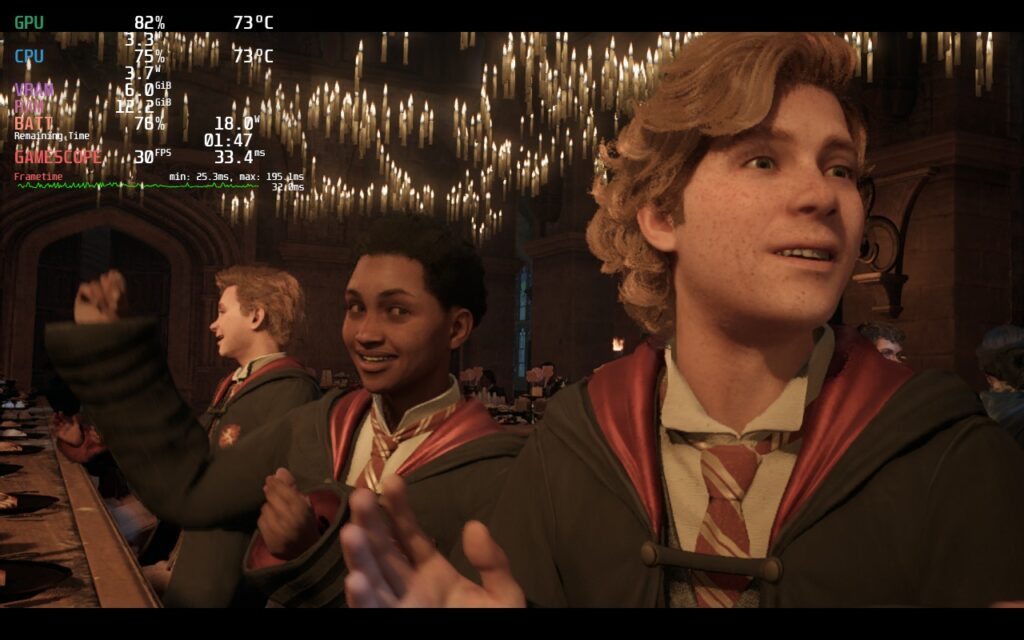
While the framerate counter says 30, the green bar below is very erratic.
While the game can handle medium graphics preset, I settled on keeping low as some areas tended to drain much more and keeping at the recommended still looked great while keeping stability. This also allowed a TDP limit of 10 to keep drain below 18W. I noticed a couple of odd things though, including almost no visual changes from low to medium. I also noticed that on Ultra, it could run at 30 in a lot of areas with high battery drain, but using Lumos cut framerate in half. Turning Lumos off went back to the normal framerate, which was a bit weird.
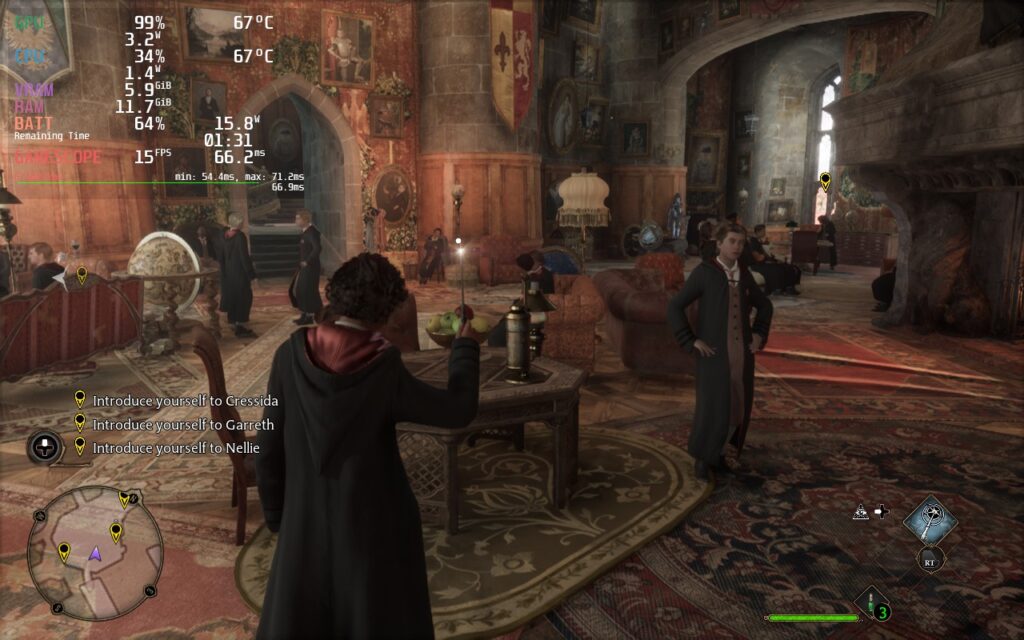
Overall, I’m actually quite impressed. Hogwarts Legacy is a new open-world game and, for the most part, holds its own while utilizing FSR 2.0 quite well. There still needs to be more testing, and hopefully the shader cache will smoothen the stuttering out in a couple days, but overall, this is going to be a solid experience on the Steam Deck! I will be going back in a couple of days once a patch and shader cache are out to go through it again, so stay tuned for an update!
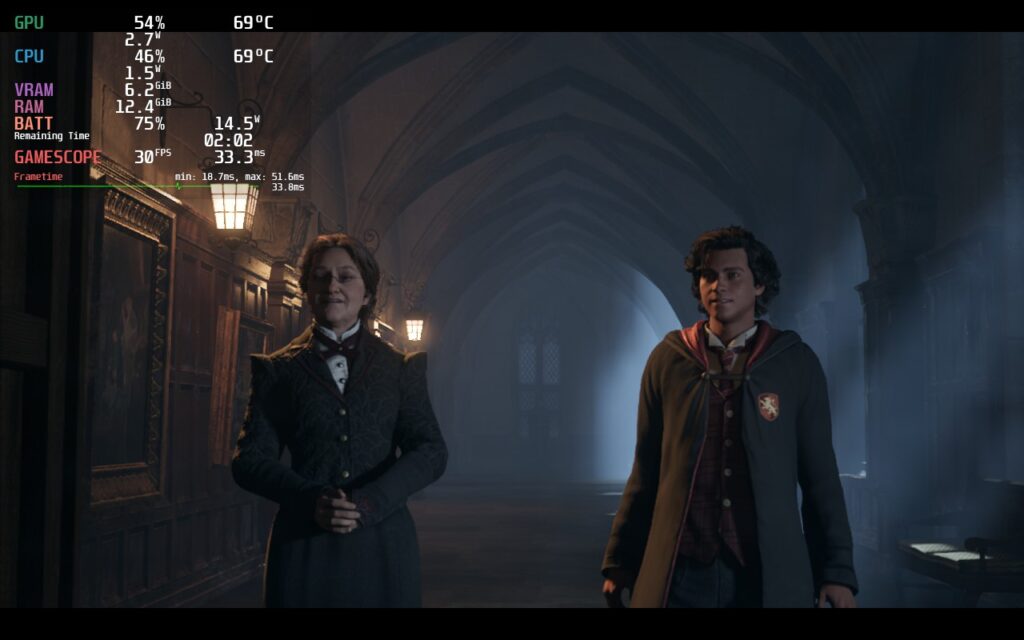
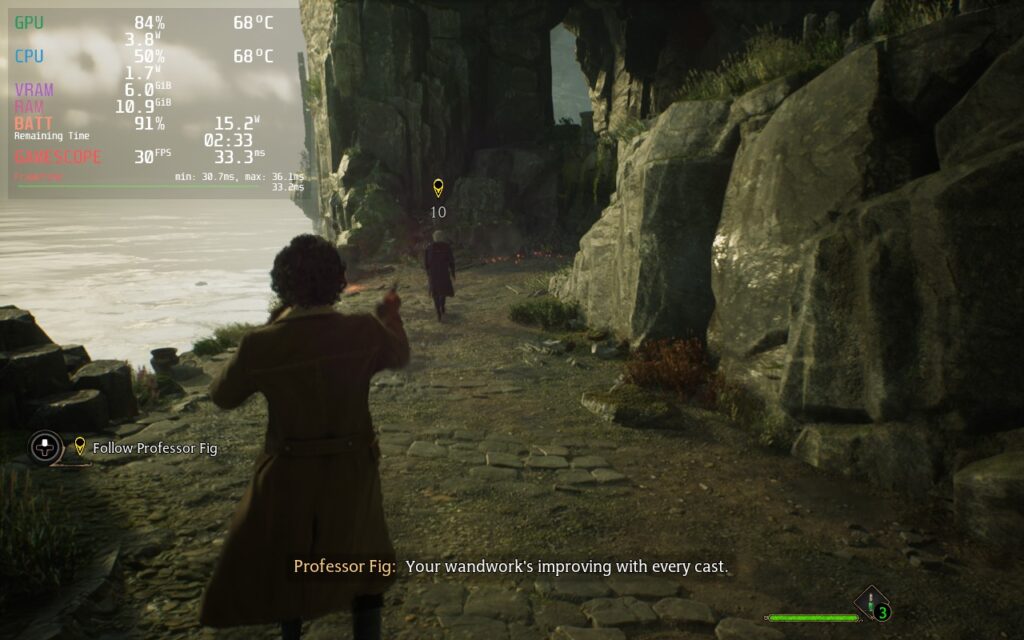
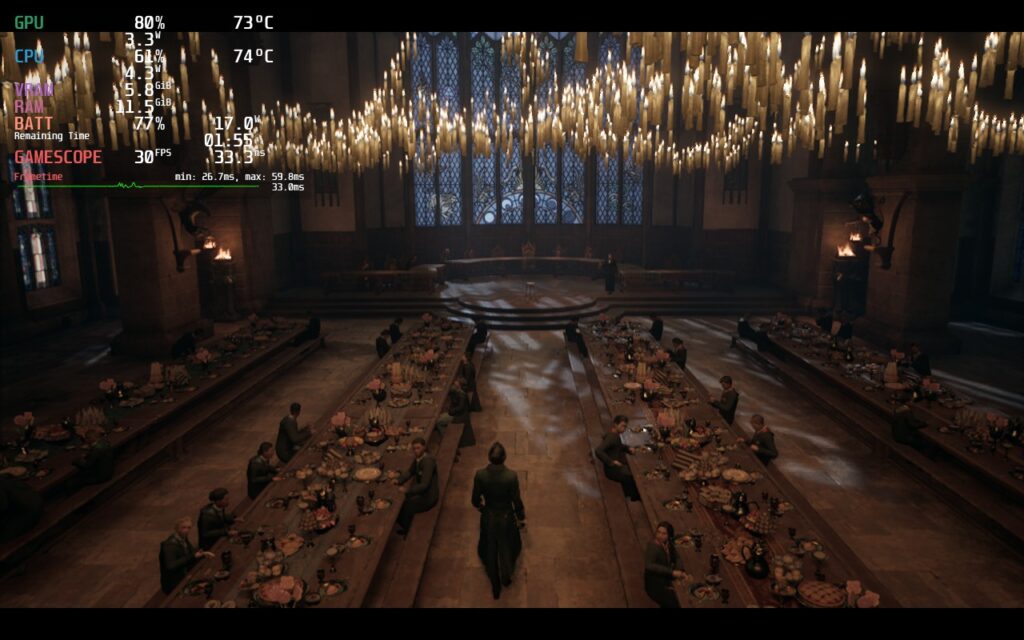
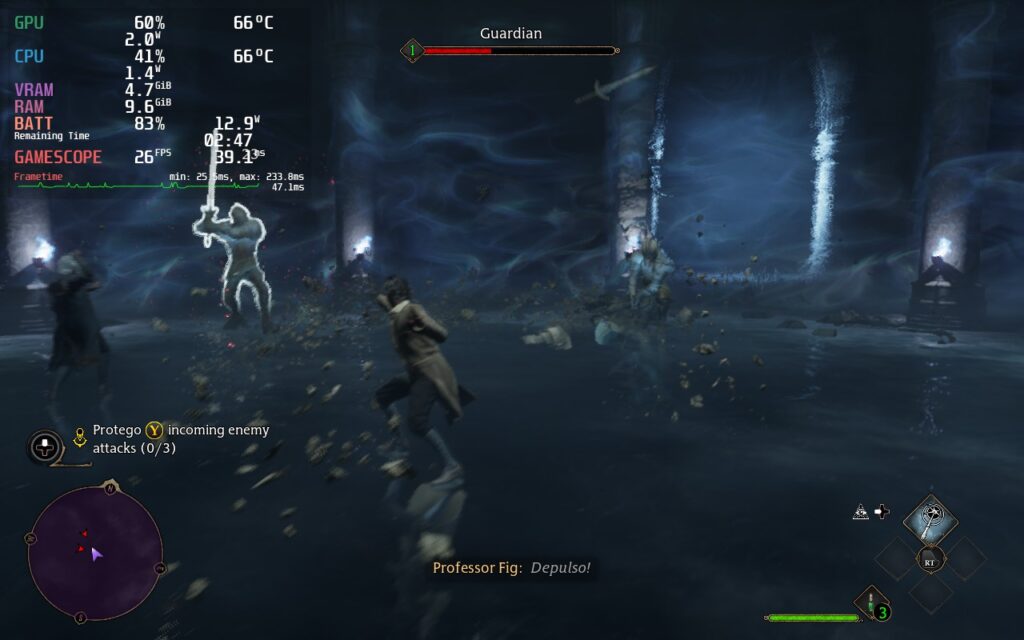
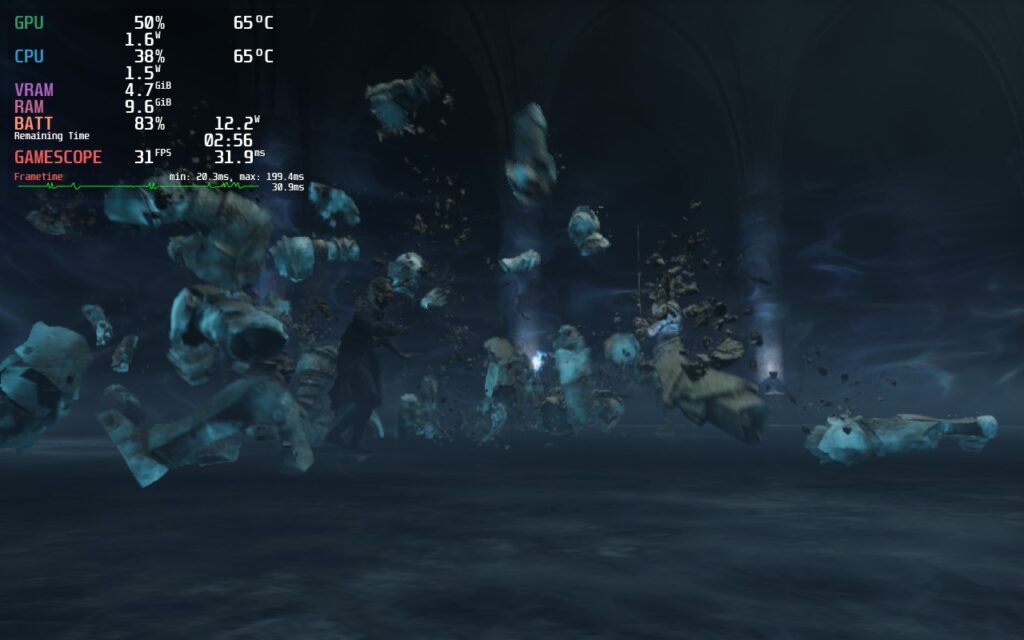
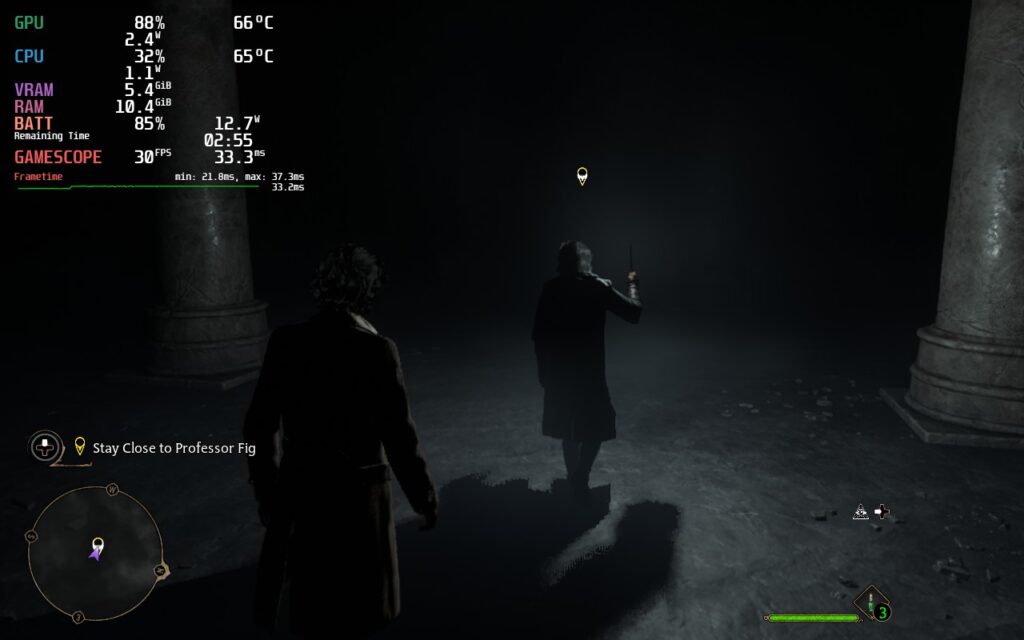
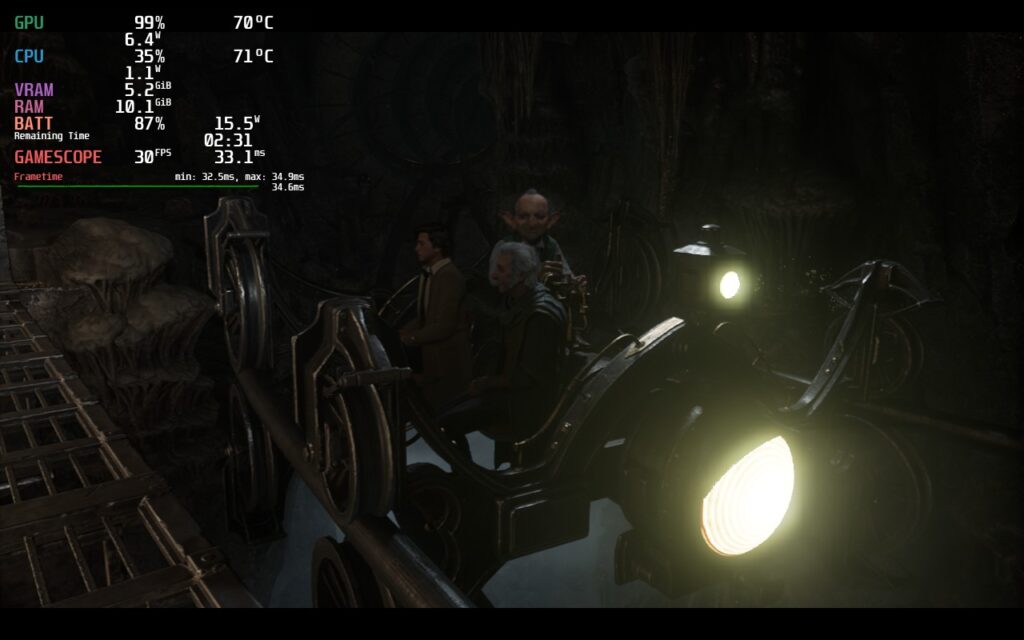
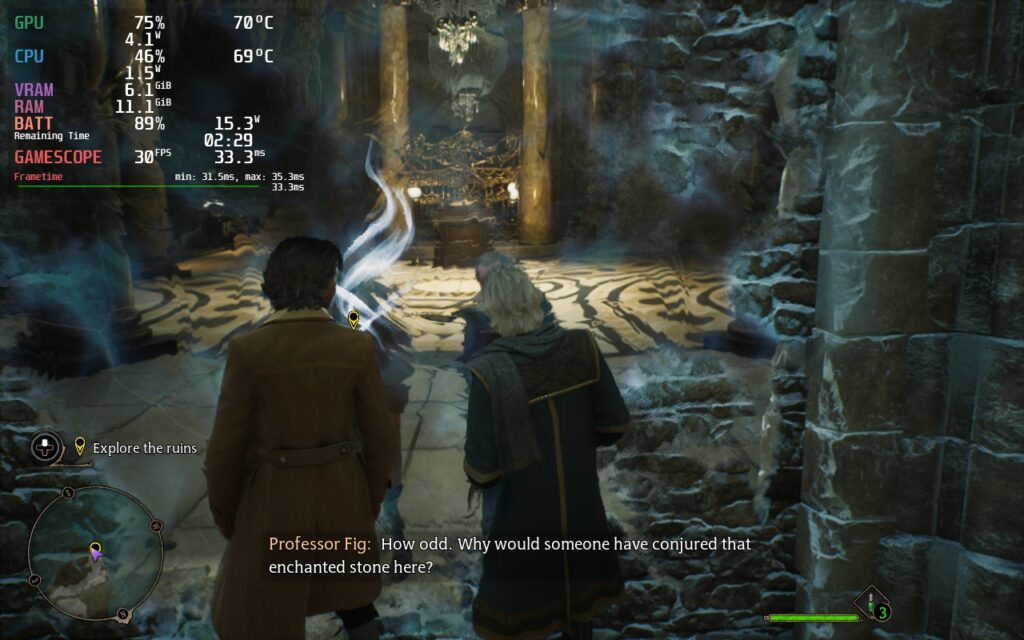
If you enjoyed this first look, be sure to check out the rest of the content on SteamDeckHQ! We have a wide variety game reviews and news that are sure to help your gaming experience. Whether you're looking for news, tips and tutorials, game settings and reviews, or just want to stay up-to-date on the latest trends, we've got your back
Thank you to Square Enix for providing us with a copy of Forspoken to review!
A young New Yorker is hitting rock bottom right before she is transported to the beautiful, broken land of Athia. Now, with her newfound magical abilities, she must traverse the desolate land and find her way home. Forspoken will have you traveling all across the open-world with magic-enhanced parkour and taking down monsters in real-time combat with a range of flashy battle and support spells. You will also level up from your encounters and grow stronger while unlocking even more abilities to enhance the way you decide to play. Will you be able to survive the twisted monsters that await and make your way home?
From my time with Forspoken so far, I have actually been enjoying it gameplay wise. The game is flashy in the right ways and I like the real-time combat. It can feel a little repetitive at first, but after more magic was unlocked, I started to feel the variety and liked mixing and matching. The world felt a little bland in its color scheme, which the vibrant plugin helped fix, but it wasn't horrible. As a game, Forspoken is one I am enjoying much more than I thought I would, due to the reviews coming out for it, but let's take a look at how it runs on the Steam Deck so far.
For a game that recommends a RTX 3070 and 24gb of RAM, I am genuinely impressed how the game runs. There are a lot of compromises to make, which makes sense seeing as how new and intensive the game is, but it is ultimately playable! The game starts you out on the lowest settings, which makes sense given how much power this game asks for, but I elected to change FSR 2 to Balanced instead of performance. The game looked significantly better and didn't add to the overall power draw. Quality was also a step up, but not enough to justify the draw.
The game was still dropping more than I would have liked it to, so I forced the resolution down to 1024x640 and upscaled through SteamOS FSR. It didn't take much away from the visuals and did help keep stability down. This also allowed the game to stick below 18W, which is pretty amazing seeing as how most other builds I am seeing have a high 23W-27W drain. There will still be some drops, and you can raise the TDP limit to account for those if preferred, but the drops to 27-28 FPS weren't noticeable due to the 30 FPS cap.
I did experience one crash when I was playing, but this was most likely due to using too much RAM as I was playing with the settings (both the texture and model streaming was set to standard). I did also experience more slowdowns and battery drain during cutscenes, but most actual gameplay held up pretty well.
One big noticeable issue is loading. The game can take a long time to load into some cutscenes and the menus. It takes about 5 seconds to fully load everything in when going into the menu and sometimes coming out of it, which can be a bit annoying, but it isn't game-breaking.
Overall, I would consider this a success for Square Enix. Forspoken does have some optimization issues across the board, which patches could definitely help, and the shared shader cache is still being put together and should help a bit too in the next few days. The game itself is more fun than I expected and it is playable on the Steam Deck. It won't look as beautiful as it would on more powerful devices, and sometimes takes a bit to load, but to be able to play this on-the-go, I felt this is a good trade-off.
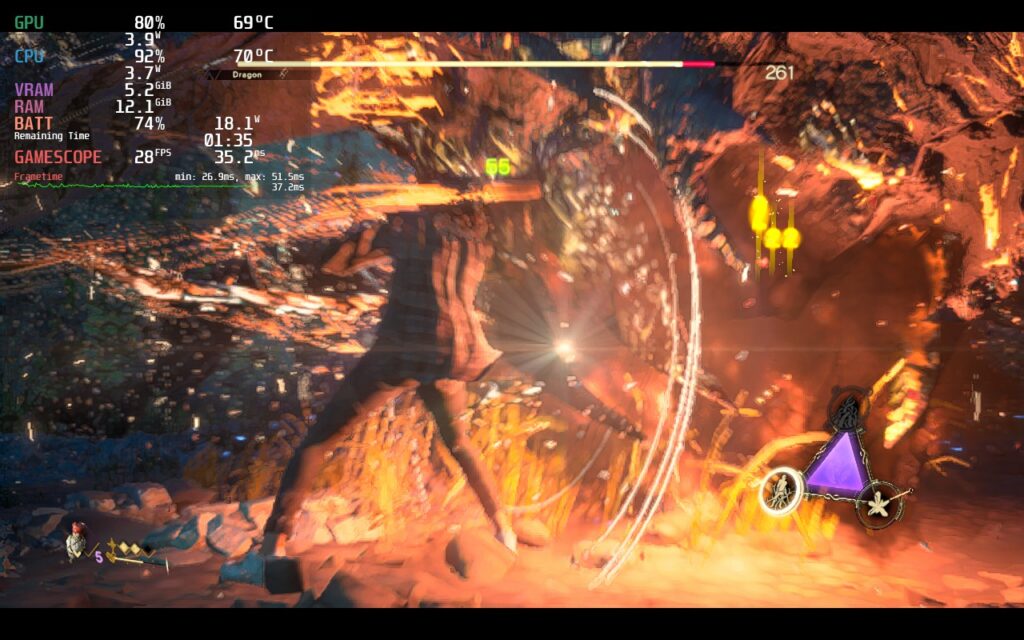
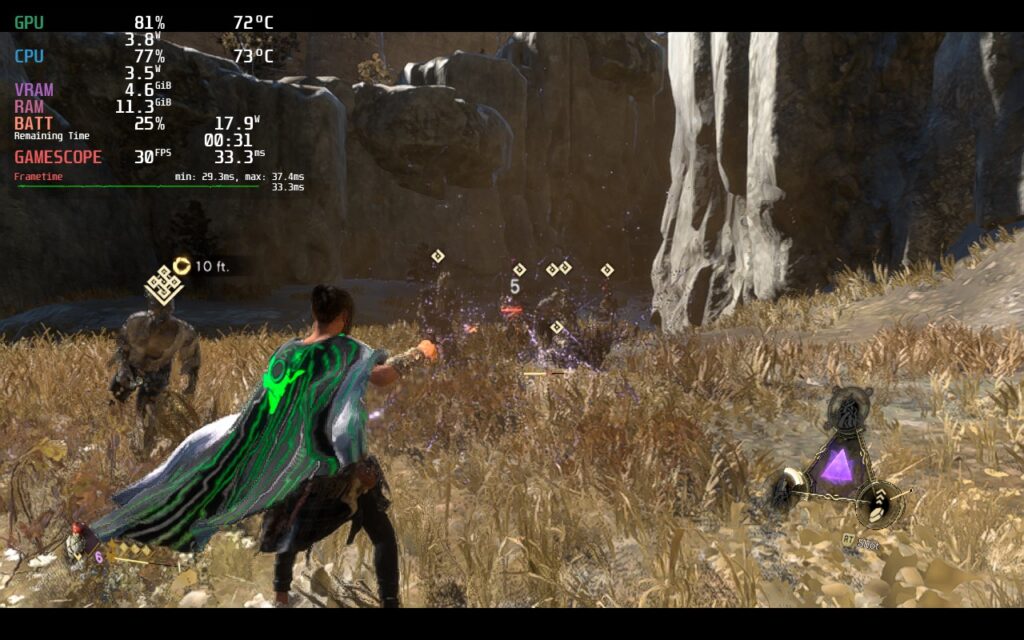
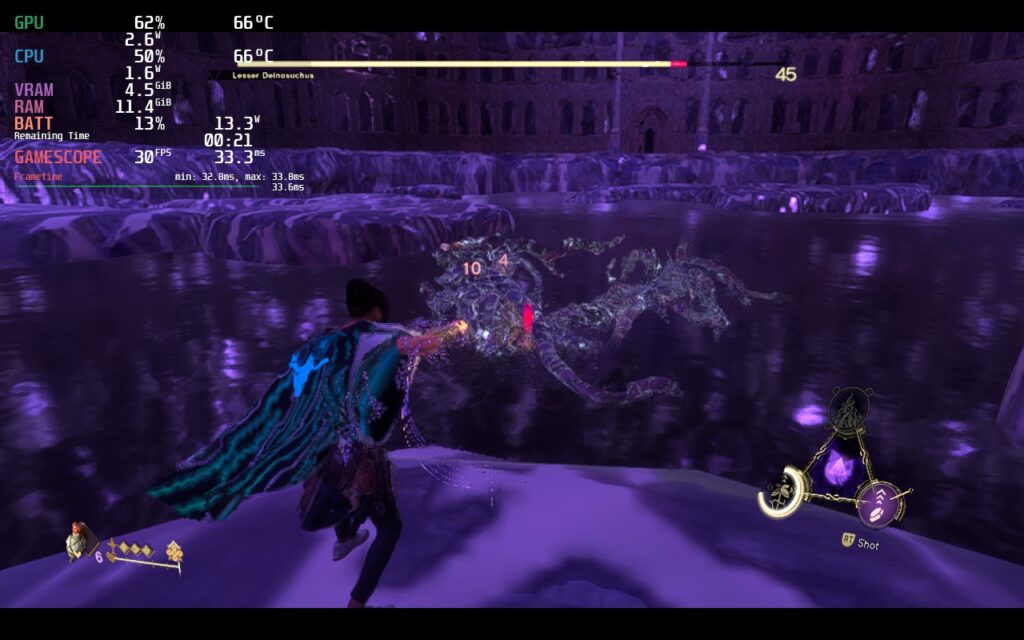
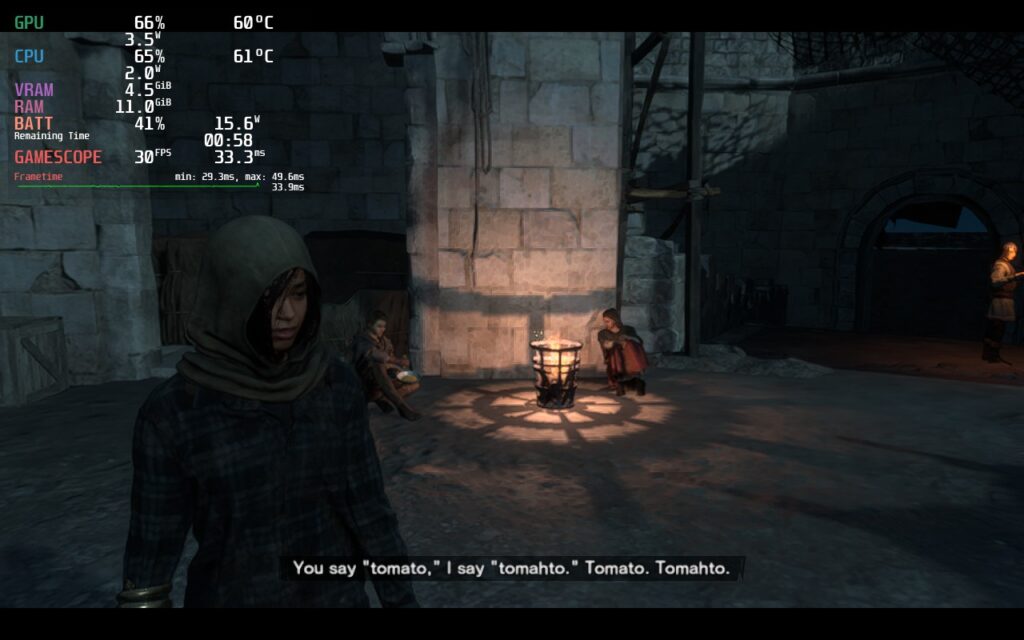
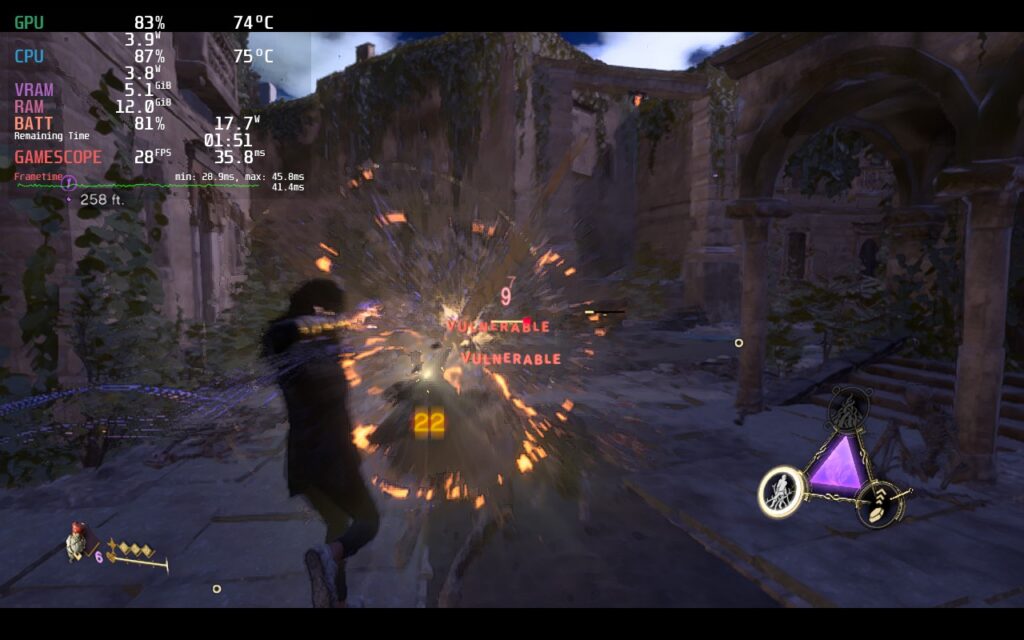
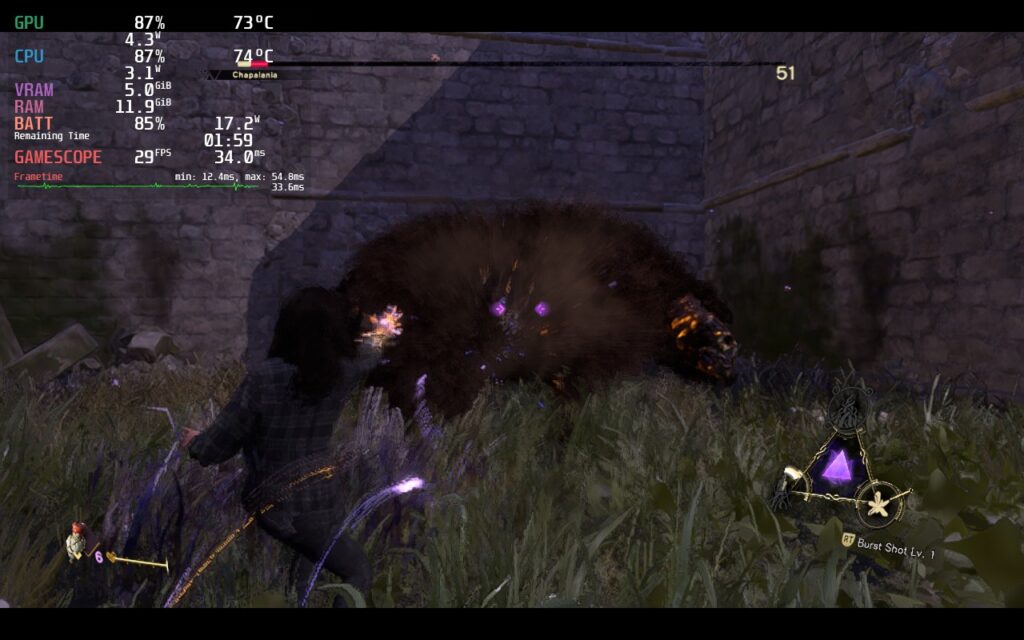
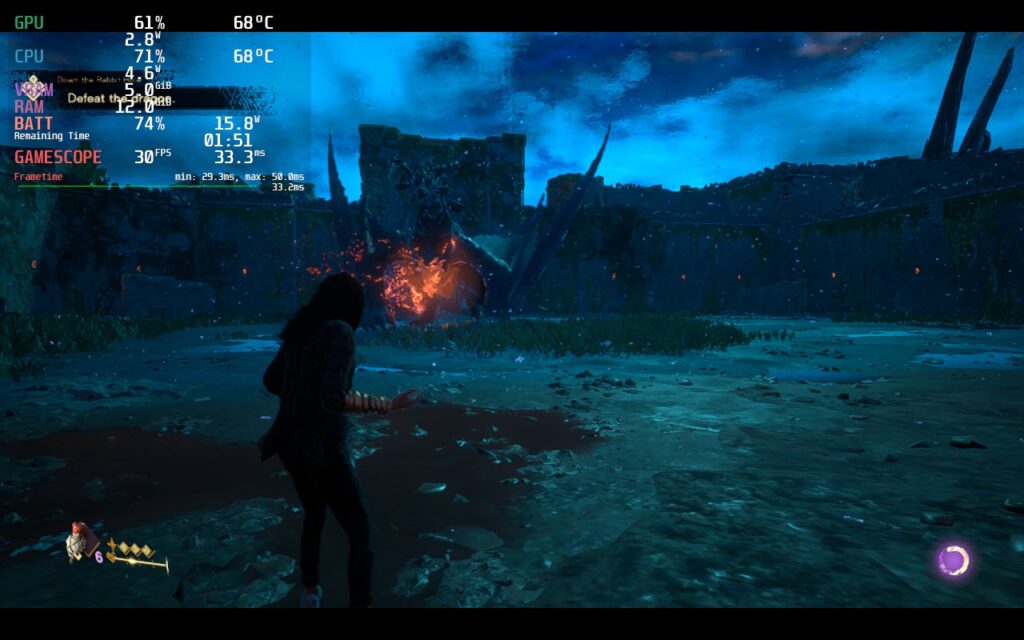
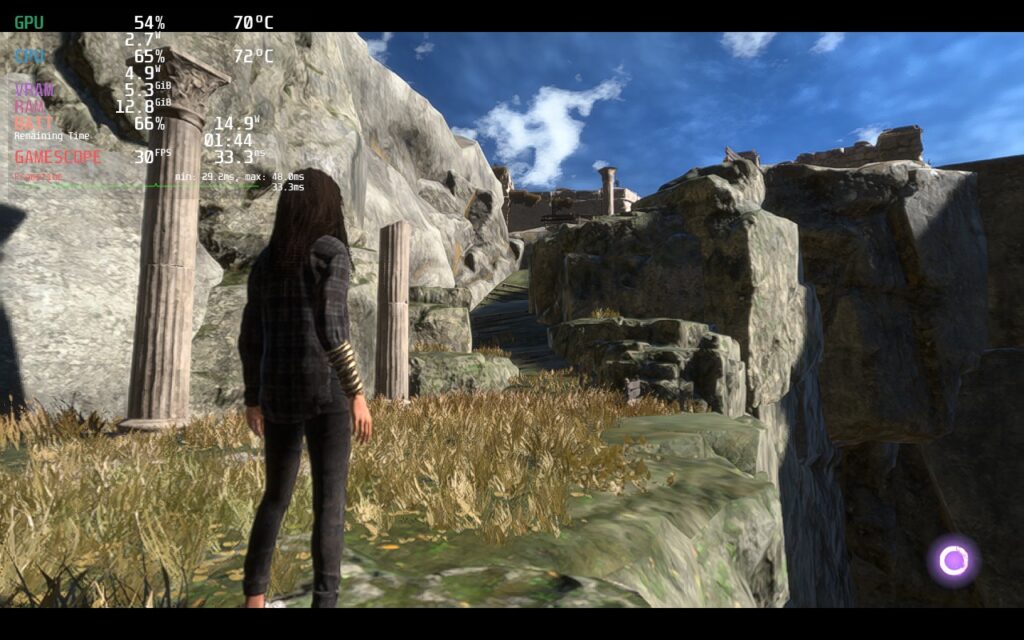
Our review is based on the PC version of this game.
If you enjoyed this first look, be sure to check out the rest of the content on SteamDeckHQ! We have a wide variety game reviews and news that are sure to help your gaming experience. Whether you're looking for news, tips and tutorials, game settings and reviews, or just want to stay up-to-date on the latest trends, we've got your back
God of War (2018) is the first game in the rebooted-ish God of War series. You play as angry man Kratos who, with his son Atreus, must honor his partner’s dying wish. Along the way, you will travel across the land, encountering the gods of the norse mythology, all while training his son to be an angry boy. This game detracts from its predecessors heavily, focusing on telling a compelling story in a third person view over a beat-em-up style game. The game is phenomenal all around and is easily one of the greatest games to have ever been made. Saying this was a worthwhile experience is an understatement, so I was praying this would run well on the Steam Deck.
Knowing how this would turn out, I started my benchmarking with everything set to max. Lo and behold, it was horrible. Everything set to max with native resolution and no caps resulted in a 20 FPS average with a 24W+ battery drain and temps that were rising up to the high 80s. And this was in one of the less heavy areas of the game. I had no intention of using max settings though and here is where the review gets a bit tricky.
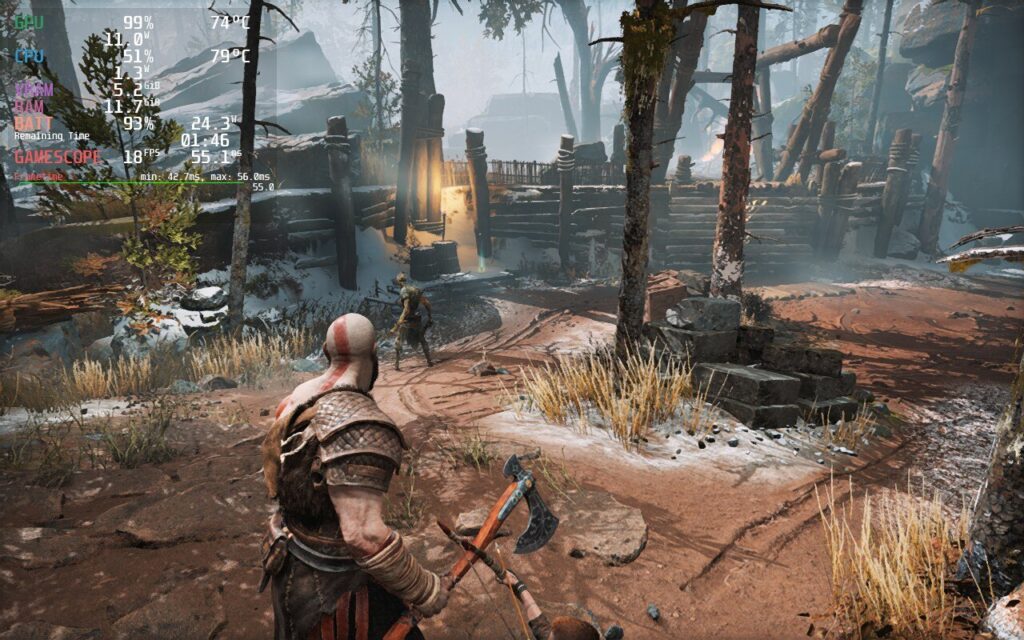
While God of War looks beautiful, battery drain and temps are high, as well as the framerate hanging around 20 FPS or lower.
God of War is a super intensive game and I feel there are two ways to play this: 30 FPS with a battery/quality focus and 40 FPS with a performance focus. In my testing, having a specific quality-focus build results in battery drain that hits a bit too hard, though it is possible to play.
Seeing as how draining God of War is, I wanted to see how far I could get the drain and temps down while keeping a stable 30. Thankfully, God of War does have FSR 2.0 integration, so I didn’t have to turn the resolution down as much to save battery. I set the TDP to 9 and started reducing some quality settings to make sure the stable framerate was hit. I ended up with a nice mix of original and high settings, with 3 of them being low. With those settings and a 1152x720 resolution with FSR 2.0 set to quality, we get a fairly nice picture with a mostly stable 30 FPS. There are some framerate spikes, but I don’t feel they are noticeable in general play without the graph there. I have seen some minor slowdowns too, but these tend to happen in cutscenes or entering new areas, which don’t impact gameplay as much. Turning up TDP could mitigate some of these, but will also drain everything much faster. Even when all the settings are set to low, I still experienced some form of spike, so while these settings may cause a little more, they still don’t feel noticeable and give more to the game while saving a significant amount of battery drain.
When it comes to 40 FPS, it is possible to achieve it while still looking quite good, though at a cost to stability. I would say overall, the game is 80% stable at 40 with these settings, though there are still mini spikes which are much more noticeable due to the increased framerate. On top of that, battery drains significantly more and temps get up to 80c, which in itself is still not that bad. It is also slightly blurrier as the resolution is changed down to 960x600, and FSR 2.0 set to balanced, but the smooth framerate does make up for this. It is still decent looking, though personally, the upgrades to quality and less noticeable spikes win out for me.
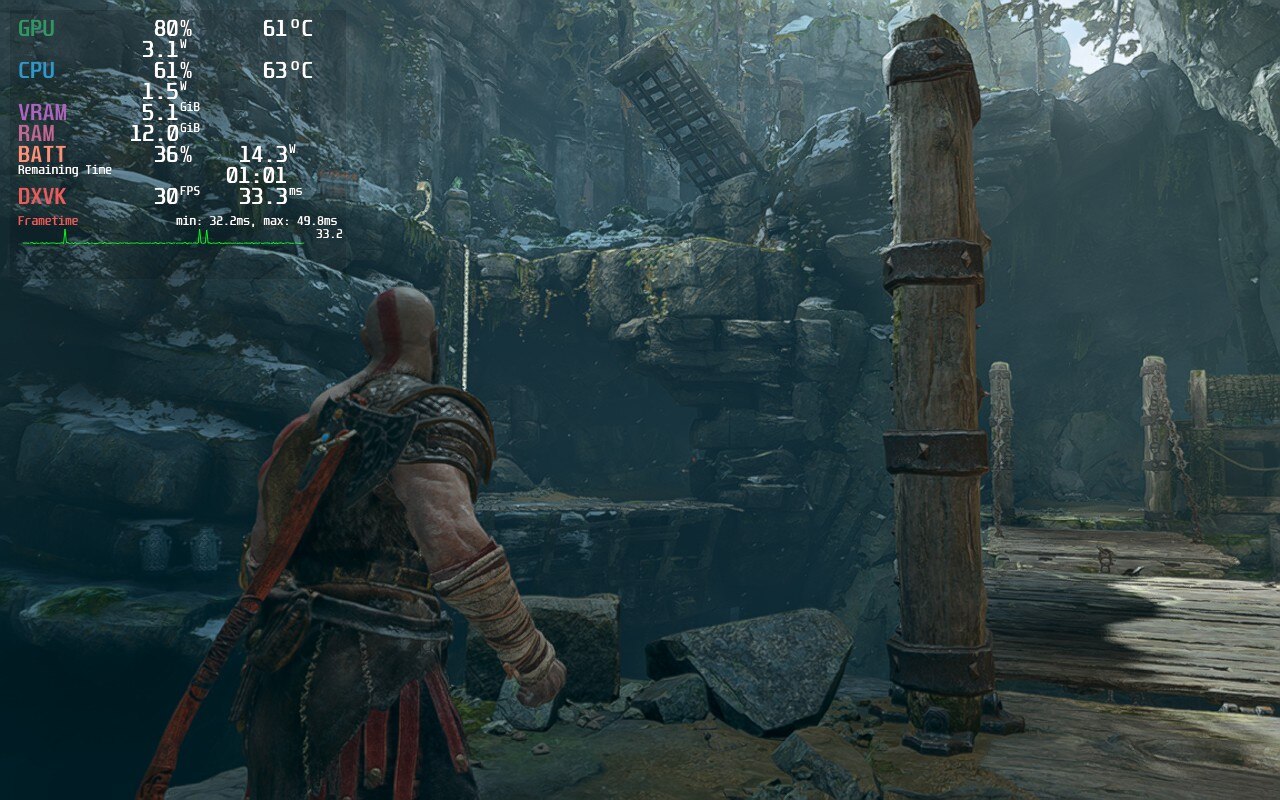
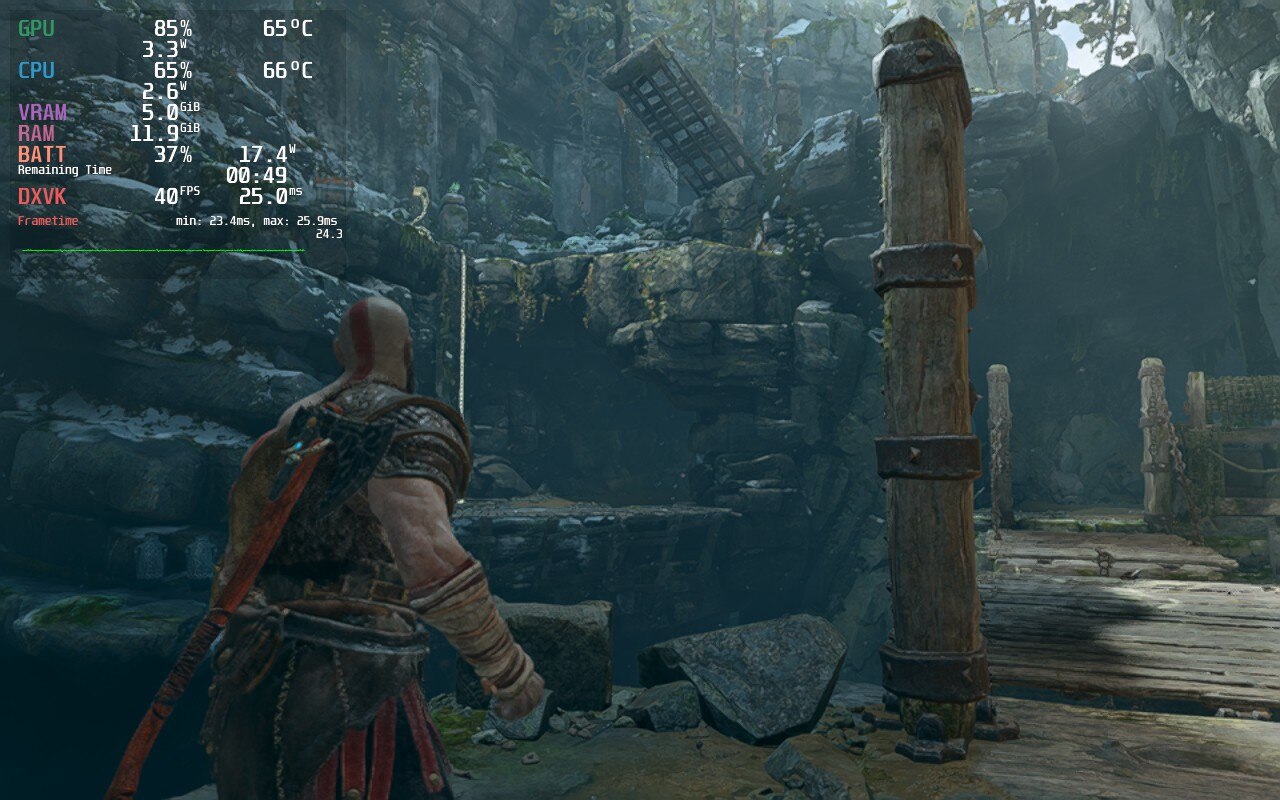
The difference in quality is clear and while 40 FPS can be hit, the temps and battery drain are massive.
There were no clear differences when using a different Proton version for God of War, so you can pick and choose which one you would like to use. I prefer using Proton GE when I can. If you don't know about it or want to install, you can follow our guide for it!
I did also encounter a couple bugs with the Deck. I noticed that after some cutscenes in God of War, my controls would stop working. This was easily fixed by hitting the "Steam" button and then going back into the game, but it was a bit annoying to deal with. I also did notice that moving the left analog stick has a very slight delay. I tested to see if this was due to SteamOS's cap, though even when Vsync in game was on with no cap, there was still that delay. It wasn't really noticeable when getting into the game though, just when I specifically stopped to test it.
I still am in shock as I tested and wrote this review, I was playing God of War on a handheld device. This game is so good and I was pleased with the performance. Of course, in terms of technicality, it could be better. It does still have framerate spikes and some bugs, but overall, this is a huge AAA game that has no business running as well as it does on Deck. If you haven't played the game before, or on the fence about it, do yourself a favor and grab the game. The compromises are well worth it.
Our review is based on the PC version of this game.
If you enjoyed this review, be sure to check out the rest of the content on SteamDeckHQ! We have a wide variety game reviews and news that are sure to help your gaming experience. Whether you're looking for news, tips and tutorials, game settings and reviews, or just want to stay up-to-date on the latest trends, we've got your back!
Final Fantasy 7 Remake Intergrade is the remake of one of the most well-known JRPG games ever made. With the original being made in 1996, this remake made a ton of changes and improvements, including a graphical overhaul, real-time combat system, and expanding the story into not just 1, but 3 parts told in 3 separate games. If you loved Final Fantasy 7 and wanted to see an intricate re-telling of the original story that expands more than you would have ever thought, this is the game for you.
FF7R on Steam Deck seems to work really well out of the box at first, but progressing through the game shows its cracks. The biggest one would be that Dynamic Resolution is automatically turned on without an in-game way of turning it off. The in-game setting selection is abysmal, only giving the option to change resolution, texture and shadow resolution, framerate cap, and characters displayed.
I was able to disable Dynamic Resolution with a mod though, which not only made the game look better, but run significantly better too. You can find this mod and how to install it below this review. With Dynamic Resolution off, I used Steam to force the resolution to 1024x640 and upscaled with FSR to save on performance, which it did while still looking very good.
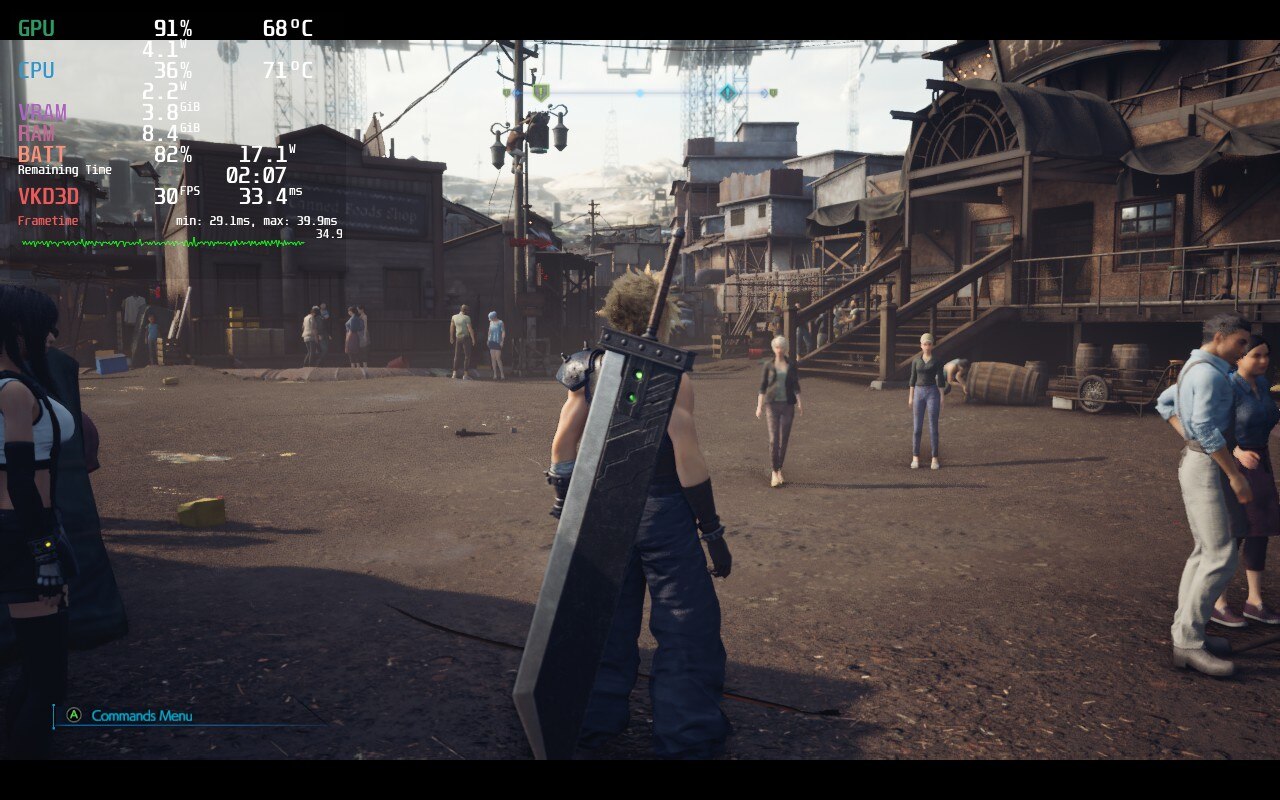
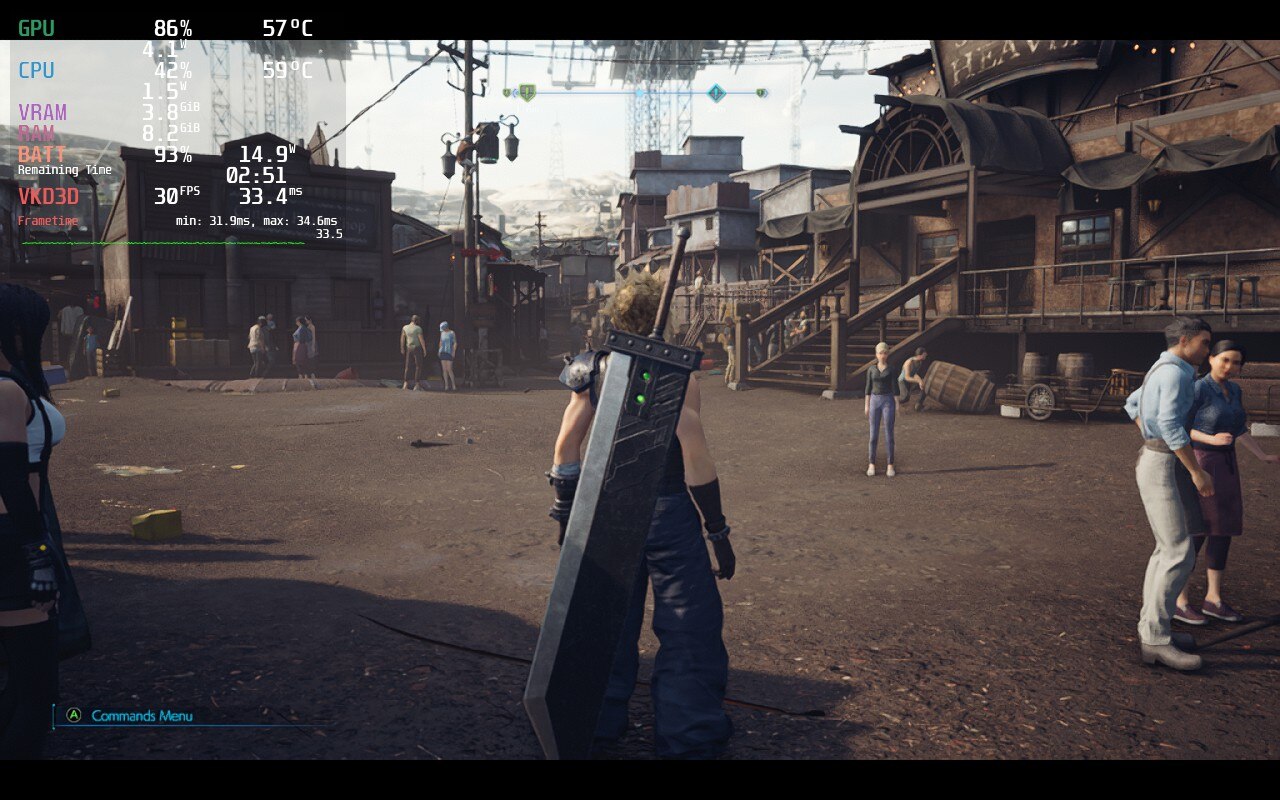
While there's slight worsening of the text, the gains in temperature and battery life are obvious and phenomenal. The 1024x600 with FSR has the disable dynamic resolution mod installed.
I tested this running through one of the most demanding areas in the game, both in the base game and its DLC, and got significantly less temps and battery usage overall while still looking better. During gameplay, I got average temps for CPU and GPU around 70c while battery usage tended to hover around 15W. I set the texture and shadow resolution to low since I felt they didn’t change a whole lot visually, but did keep the framerate more stable. I didn’t see a whole lot changed with characters displayed, so I kept it at 2 and the framerate cap can be set to 30 or 60.
If you plan to use our 40 FPS build, or switch between the two builds we provided, keep this set to 60 in-game. Though I would recommend sticking with a more stable 30 FPS as it is significantly better with temps and battery throughout the game overall. I did also try launching with DX11, but I didn't feel there was any major difference in performance to warrant it.
Throughout my testing, regardless of how I set the game, there were stutters when running through areas. This is actually due to the engine this game runs on, Unreal Engine 4. On Steam Deck, when a UE4 game is loading in new assets/areas, it has been known to stutter pretty wildly. It calms down really quick, and doesn’t necessarily affect temps or battery much, but it is noticeable. Other than that, I didn’t really notice any bugs or glitches.
Final Fantasy 7 Remake is a wonderful fit for the Steam Deck. I have always felt like JRPGs are perfect on this device and this just confirms that. With the recommended build, I would say FF7R is very playable and an enjoyable experience. I would have loved 40 FPS to be a bit more stable, and it still is a little blurry even just getting the settings right, but it is playable. Needing to mod it to make it playable is a little bit of a nuisance too, but it is a huge help being able to disable that. Overall, I would recommend playing the game on Steam Deck, just note that it is a little process with some compromises.
Need some help understanding how we got to our score? Check out our Guide to Steam Deck HQ.
Our review is based on the PC version of this game.
If you enjoyed this review, be sure to check out the rest of the content on SteamDeckHQ! We have a wide variety game reviews and news that are sure to help your gaming experience. Whether you're looking for news, tips and tutorials, game settings and reviews, or just want to stay up-to-date on the latest trends, we've got your back!
Tiny Tina’s Wonderlands is the newest entry in the Borderlands series, but with a unique DND twist. The game retains its looter shooter DNA and rolls in some stat building and a full overworld with random encounters and secrets to explore. This kind of one-off encounters and dungeons are a perfect fit for the Steam Deck’s pick-up and put-down style. Coupled with the Borderlands charm, this is one of the best Borderlands yet!
Gameplay aside, I was astounded by the ease of configuring the game. Due to the graphical style, upscaling through SteamOS FSR brought the 1024x640 resolution looking close to native, while saving a significant chunk on performance and battery.
To change resolution, go to the cog wheel for the game and under the general tab, change the resolution to 1024x640. With my test of FSR 2.0 though, I felt it didn't make a significant enough difference for the recommended build, but helped stabilize the 40 FPS build.
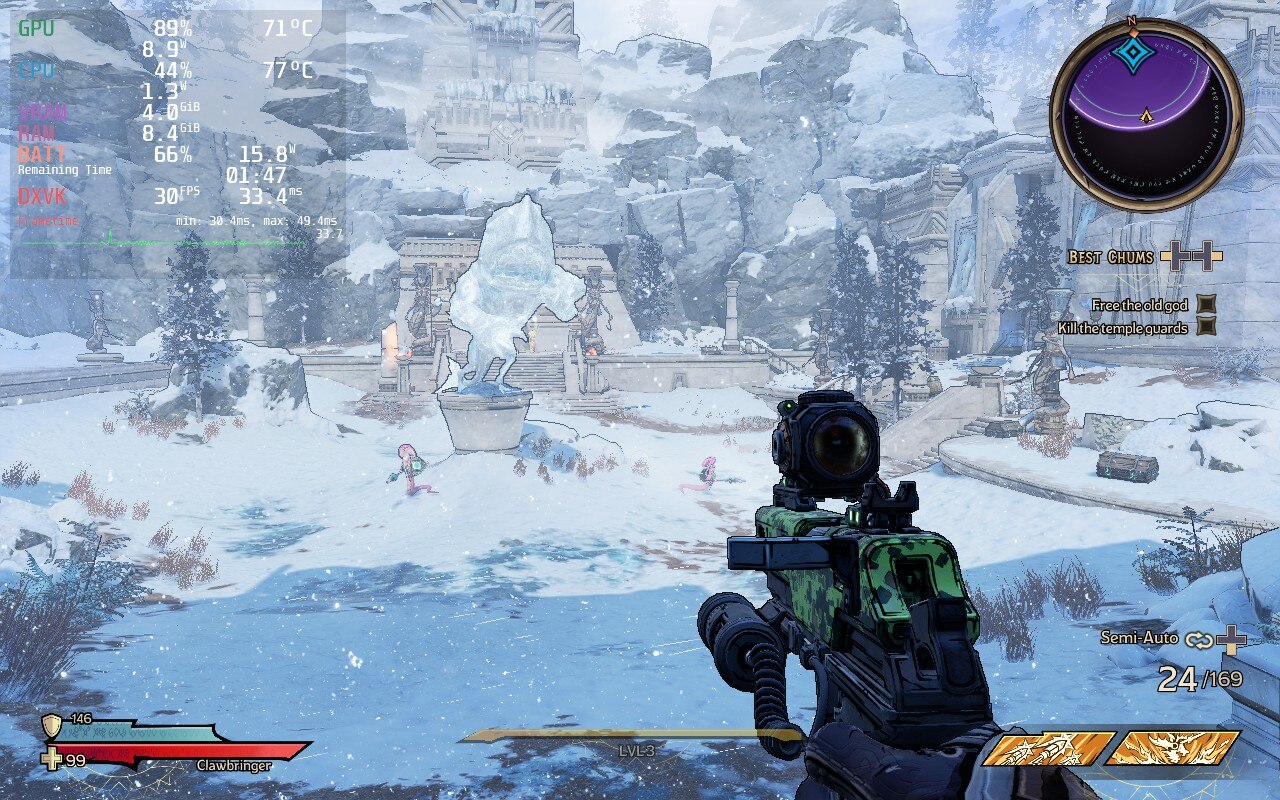
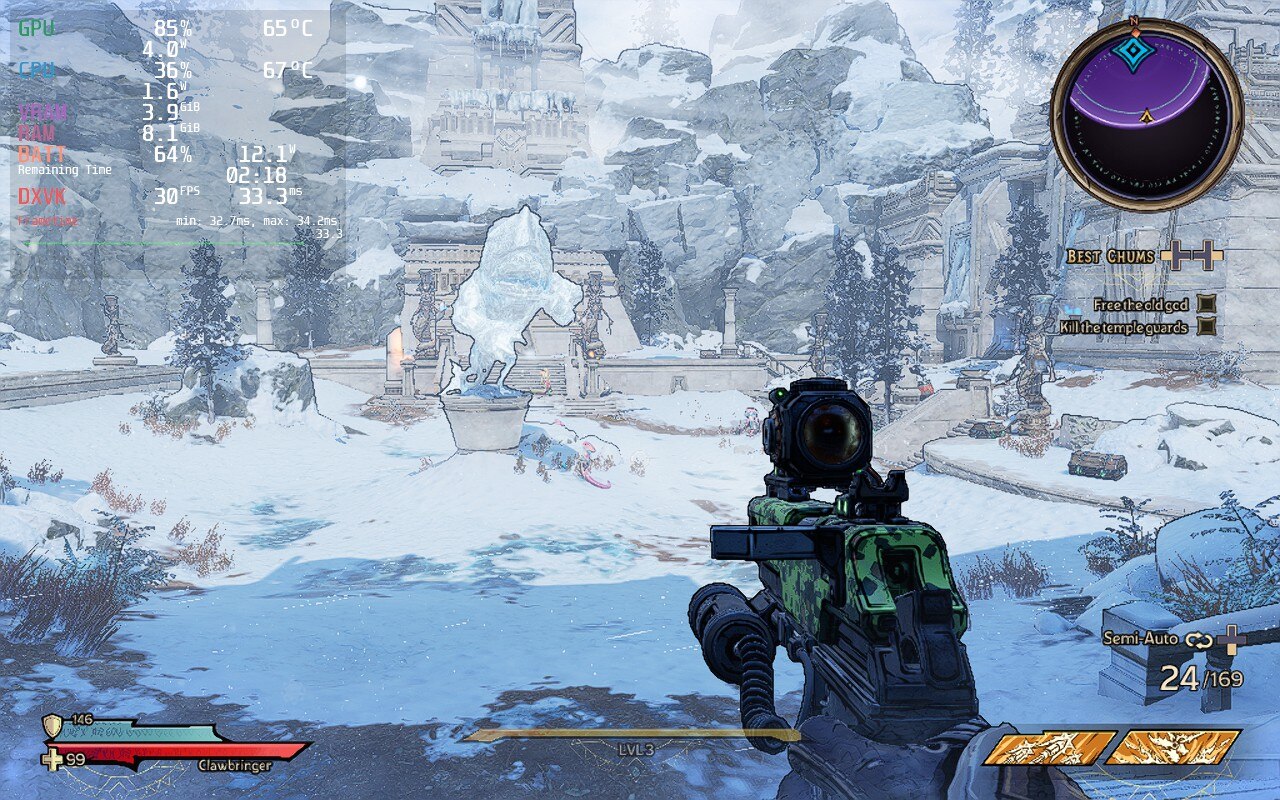
The text is a little blurrier at 1024x640, but the sharpness is noticeably better with a fantastic saving to battery and temps.
30 FPS lock was very stable on Tiny Tina's Wonderlands. I did test 40 FPS a couple times, but my Deck shut itself down from overheating while trying to test it, do not have TDP limit off for 40 FPS.
I also ended up turning the in-game settings to medium, anti-aliasing off, and draw distance to low. I didn’t feel these inhibited the look of the game and ended up saving even more battery while keeping temps to around 65c - 70c.
Proton GE is also required simply due to the videos in the game being broken trying to use regular proton. I also checked DX11 vs DX12 and felt there was minimal difference, so either or can be chosen. Multiplayer did end up increasing battery by 1W, but temps largely remained the same and it still felt stable.
Throughout gameplay, I didn’t really feel any huge bugs or glitches that inhibited my playthrough. I did encounter one bug where when I paused the game and tried to scroll down on the menu, my first button press downwards would bring me back up. I did also have 1 crash trying to go into a mirror in a town, but so far that has been an isolated incident. This is a UE4 game as well, so expect some temp and battery spikes when loading environments in.
Tiny Tina's Wonderlands runs significantly better than I could have expected. For a game that really just came out not long ago, it runs cold and stable most of the time. Other than the spikes from loading the environment in, fights are stable and looking gorgeous. With multiplayer being so easy on the system, this is a perfect fit for a portable device.
If you need help understanding how to use this guide, don't forget to check out the How to use SDHQ tutorial!
Our review is based on the PC version of this game.
If you enjoyed this review, be sure to check out the rest of the content on SteamDeckHQ! We have a wide variety game reviews and news that are sure to help your gaming experience. Whether you're looking for news, tips and tutorials, game settings and reviews, or just want to stay up-to-date on the latest trends, we've got your back!